#Output NYC
Text
why scan?
scanning is something i've done for probably about 12 years now (i'm ancient, for this site), with varying degrees of regularity, intensity, etc. it has ratcheted up since the dawn of 2023, though, which begs the question: why? why put so much time into what could not-wrongly be considered a passive activity, hunched over a piece of clunky machinery with the express purpose of preserving others' creations? the answers are several, and fascinating (not really).
i am a [sober] drug addict. anything i pursue, consume, create--more often than not--ends up taking on addictive qualities. i'll eat the same specific food item for a month, then never want to see, let alone taste it, again. i'll listen to one song on repeat for days until i'd rather hear nails on a chalkboard than have it shuffle on and assault my ears. one of the reasons that my scanning has increased in volume recently is that i acquired library cards to the 3 nyc library systems: nypl, brooklyn, and queens. as soon as i was able to, i pillaged + plundered those fine centers of learning, leaving any given library with as many hefty scan-worthy books as i could [barely] carry. here, finally, was a *free* way of obtaining more + more + more visual media to consume.
2023 saw me get my first legal, full-time job. as such, my adjusting to that hellish reality resulted in a steep decline in my own personal creative output. collaging, writing, and rapping all fell to the wayside as i slowly acclimated to a life of work that almost everyone else my age has known for over a decade is generally unbearable + detrimental to the maintenance of outside pursuits. in times of famine within my own artistic harvest, scanning, archiving, and sharing others' work is a means of feeling as though i am still contributing to the global oeuvre.
there’s an element of losing my mental self in a series of physical motions that becomes almost automatic after some time. “zoning out” is not something endemic to my daily life; if anything, i’m almost always too zoned in. relief is necessary. especially considering the shitshow this past year has been in terms of my personal life.
i am a product of capitalism’s cultivating a craving for constant consumption.
it seems that visual content is only going to continue to get more + more uninspired. has everything been done? did social media ruin it all? in any case, i feel a need to document the past. to a degree, it’s my version of doomsday prepping. (god forbid books go extinct altogether.)
i have always gravitated towards solitary activities. this topic could be a thesis in its own right.
i thrive on external validation. this reliance is something i’ve improved upon over the past several years, but it hasn’t been altogether extinguished. even though the materials i scan are not of my own creation, i nevertheless feel a vague pride in showcasing them. occasional appreciation thereof satisfies this fixation on others’ attention, albeit in a diluted form.
i am fortunate to live in a city bursting to the gills with cultural institutions. i am also lucky enough to have some disposable income that can be directed toward fulfilling my ravenous desire for visual media.
((i keep getting messages about the specifics of my scanner + "process":
i have a cheap ass hp envy 6055e and i just use the software it comes with.
there's nothing special or fancy happening here, and i could definitely invest in a better and/or a large format scanner, etc. but i really just don't care enough and it's not like i'm getting paid for this lmao))
1K notes
·
View notes
Text
2600’s amazing Hackers on Planet Earth con may go down under enshittification

Catch me in Miami! I'll be at Books and Books in Coral Gables on Jan 22 at 8PM.

It's been 40 years since Emmanuel Goldstein launched the seminal, essential, world-changing 2600: The Hacker Quarterly. 2600 wasn't the first phreak/hacker zine, but it was the most important, spawning a global subculture dedicated to the noble pursuit of technological self-determination:
https://www.2600.com/
2600 has published hundreds of issues in which digital spelunkers report eagerly on the things they've discovered by peering intently at the things no one was supposed to even glance at (I'm proud to be one of those writers!). They've fought legal battles, including one that almost went to the Supreme Court:
https://en.wikipedia.org/wiki/DeCSS
They created a global network of meetups where some of technology's most durable friendships and important collaborations were born. These continue to this day:
https://www.2600.com/meetings
And they've hosted a weekly radio show on NYC's WBAI, Off the Hook:
https://wbai.org/program.php?program=76
When WBAI management lost their minds and locked the station's most beloved hosts out of the studio, Off the Hook (naturally) led the rebellion, taking back the station for its audience, rescuing it from a managerial coup:
https://twitter.com/2600/status/1181423565389942786
But best of all, 2600 gave us HOPE – both in the metaphorical sense of "hope for a better technological tomorrow" and in the literal sense, with its biannual Hackers On Planet Earth con:
https://en.wikipedia.org/wiki/Hackers_on_Planet_Earth
For decades HOPE had an incredible venue, the Hotel Pennsylvania (memorialized in the phreak anthem "PEnnsylvania 6-5000"), a crumbling pile in midtown Manhattan that was biannually transformed into a rollicking, multi-day festival of forbidden technology, improbable feats, and incredible presentations. I was privileged to keynote HOPE in 2016:
https://www.youtube.com/watch?v=f1D7APjmVbk
But after the 2018 HOPE, the Hotel Pennsylvania was demolished to make way for the Penn15 (no, really) skyscraper, a vaporware mega-tower planned as a holding pen for luxury shopping and empty million-dollar condos sold to offshore war-criminals as safe-deposit boxes in the sky. The developer, Vornado (no, really) hasn't actually done all that – after demo'ing the Hotel Pennsylvania, they noped out, leave a large, unusable scar across midtown.
But HOPE wasn't lost. In 2022, the ever-resilient 2600 crew relocated to Queens, hosted by St John's University – a venue that was less glamorous that the Hotel Pennsylvania, but the event was still fantastic. Attendance fell from 2,000 to 1,000, but that was something they could work with, and reviews from attendees were stellar.
Good thing, too. 2600 is, first and foremost, a magazine publisher, and these have been hard years for magazines. First there was the mass die-off of indie bookstores and newsracks (I used to sell 2600 when I was a bookseller, and in the years after, I always took the presence of 2600 on a store's newsrack as an unimpeachable mark of quality).
Thankfully for 2600, their audience is (unsurprisingly) a tech-savvy one, so they were able to substitute digital subscriptions for physical ones:
https://www.2600.com/Magazine/DigitalEditions
Of course, many of those subscriptions came through Amazon's Kindle, because nerds were early Amazon adopters, and because the Kindle magazine publishing platform offered DRM-free distribution to subscribers along with a fair payout to publishers.
But then Amazon enshittified its magazine system. Having locked publishers to its platform, it rugged them and killed the monthly subscription fees that allowed publishers to plan for a steady output. Publishers were given a choice: leave Amazon (and all the readers locked inside its walled garden) or put your magazine into the Kindle Unlimited system:
https://www.amazon.com/kindle-dbs/arp/B0BWPTCP4K?deviceType=A1FG5NAKX0MRJL
Kindle Unlimited is an all-you-can-eat program for Kindle, which pays publishers and writers based on a system that is both opaque and easily gamed, with the lion's share of the money going to "publishers" who focus on figuring out how to cheat the algorithm. Revenues for 2600 – and all the other magazines that Amazon had sucked in and sucked dry – fell off a cliff.
Which brings me to the present moment. After 40 years, 2600 is still at it, having survived the bookstorepocalypse, the lunacy of public radio management, the literal demolition of their physical home by an evil real-estate developer, and Amazon's crooked accounting.
This is 2600, circa 2024, and 2024 a HOPE year:
https://www.hope.net/
Once again, HOPE has been scheduled for its new digs in Queens, July 12-14. Last week, HOPE sent out an email blast to their subscribers telling them the news. They expected to sell 500 tickets in the first 24 hours. They didn't even come close:
https://www.2600.com/content/hope-ticket-sales-update
It turns out that Google and the other major mail providers don't like emails with the word "hacker" in them. The cartel that decides which email gets delivered, and which messages go to spam, or get blocked altogether, mass-blocked the HOPE 2024 announcement. Email may be the last federated, open platform we have, but mass concentration has created a system where it's nearly impossible to get your email delivered unless you're willing to play by Gmail's rules:
https://pluralistic.net/2021/10/10/dead-letters/
For Emmanuel Goldstein, founder of 2600 and tireless toiler for this community, the deafening silence following from that initial email volley was terrifying: "like some kind of a "Twilight Zone" episode where everyone has disappeared."
The enshittification that keeps 2600's emails from being delivered to the people who asked to receive them is even worse on social media. Social media companies routinely defraud their users by letting them subscribe to feeds, then turning around to the people and organizations that run those feeds and saying, "You've got x thousand subscribers on this platform, but we won't put your posts in their feeds unless you pay us to 'boost' your content":
https://www.eff.org/deeplinks/2023/04/platforms-decay-lets-put-users-first
Enshittification has been coming at 2600 for decades. Like other forms of oddball media dedicated to challenging corporate power and government oppression, 2600 has always been a ten-years-ahead preview of the way the noose was gonna tighten on all of us. And now, they're on the ropes. HOPE can't sell tickets unless people know about HOPE, and neither email providers nor social media platforms have any interest in making that happen.
A handful of giant corporations now get to decide what we read, who we hear from, and whether and how we can get together in person to make friends, forge community, rabble-rouse and change the world. The idea that "it's not censorship unless the government does it" has always been wrong (not all censorship violates the First Amendment, and censorship can be real without being unconstitutional):
https://pluralistic.net/2022/12/04/yes-its-censorship/
What can you do about it? Well, for one thing, you can sign up for HOPE. It's gonna be great. They've got sub-$100 hotel rooms! In New York City!
https://store.2600.com/products/tickets-to-hope-xv
If you can't make it to HOPE, you can sign up for a virtual membership:
https://store.2600.com/products/tickets-to-hope-xv-virtual-attendee
You can submit a talk to HOPE:
https://www.hope.net/cfp.html
You can subscribe to 2600, in print or electronically (I signed up for the lifetime print subscription and it was a bargain – I devour every issue the day it arrives):
https://store.2600.com/collections/subscriptions-renewals
2600 is living a decade in the future of every other community you care about, weird hobby you enjoy, con you live for, and publication you read from cover to cover. If we can all pull together to save it, it'll be a beacon of hope (and HOPE).

I'm Kickstarting the audiobook for The Bezzle, the sequel to Red Team Blues, narrated by @wilwheaton! You can pre-order the audiobook and ebook, DRM free, as well as the hardcover, signed or unsigned. There's also bundles with Red Team Blues in ebook, audio or paperback.

If you'd like an essay-formatted version of this post to read or share, here's a link to it on pluralistic.net, my surveillance-free, ad-free, tracker-free blog:
https://pluralistic.net/2024/01/19/hope-less/#hack-the-planet
#pluralistic#2600#hackers#magazines#publishing#kindle unlimited publishing#kindle#enshittification#monopoly#end to end#competition#events#nyc#hope#hackers on planet earth#amazon
418 notes
·
View notes
Text

For those in the northern hemisphere, we're experiencing a solar storm right now (May 11, 2024) that's bringing auroras down into lower latitudes! If you're at or just below 40 degrees north or south (Madrid, Beijing, Boulder CO, NYC, Tasmania, the South Island, and Buenos Aires) , you have a good chance of visible auroras, especially if you don't have much light pollution in your northern or southern sky!
My area was clouded over, but I could tell something was happening for much of the night, because the thin spots in the high clouds looked significantly brighter than they should've at a moonless hour. I kept a window shade open to the north and kept things dark enough to watch the sky, and just around midnight I saw a gap in the clouds!
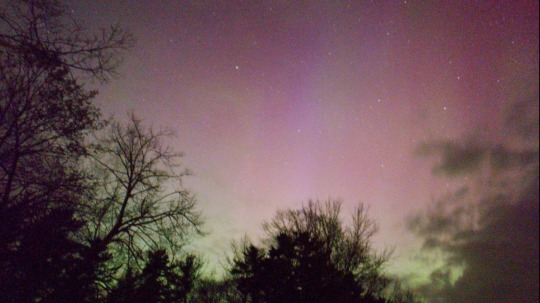
To the naked eye, this looked like a pale haze that moved and pulsed in odd ways. But with the help of my phone camera's pro mode and some ten second exposures braced against a solid surface, I managed to capture these! These are directly from the raw image files, rather than the post-processed ones phones often output by default, so this is an honest look at what the camera sensor picked up.
The solar storm is likely to continue over the weekend, so if you're at the right latitude, keep an eye out. I also recommend those without DSLR cameras getting familiar with how to take long exposures on their phone--mine has a dedicated "night mode", but that was not enough to get these pictures! If the aurora is pale, you need at least ten seconds, and ideally the raw image files, usually hidden away in some sort of pro mode. The postprocessed outputs were actually more washed out for some reason.
Keep an eye on the skies, and the US National Weather Service's Space Weather page, which includes observations and forecasts for up to 45 minutes ahead of present conditions.
61 notes
·
View notes
Text
Aaron Lange, Peter Laughner, and the Terminal Town of Cleveland, Ohio
Cleveland-based artist, Aaron Lange, tackles his first graphic novel, Ain't It Fun -- a deep dive into the oily depths of the Rust Belt's most influential music town, it's most mythological misfit, it's oft-forgotten artistic and political streaks, and beyond...
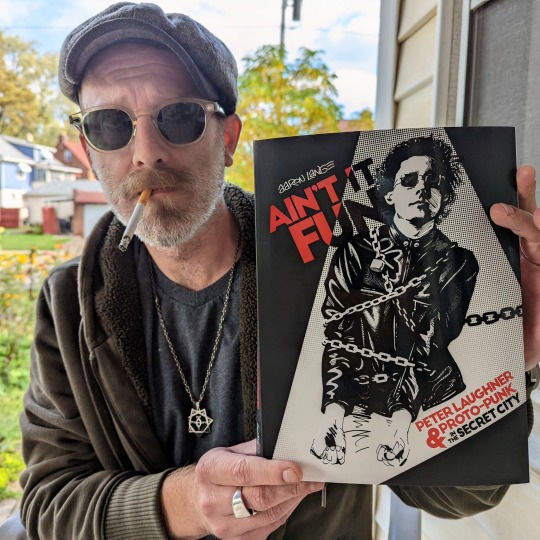
Aaron Lange and his book, 2023 (Photo by Jake Kelly)
--------------------------------------
There’s a recurring line in Aaron Lange’s remarkable new graphic novel, Ain’t It Fun (Stone Church Press, 2023), that states, “Say the words out loud. The River isn’t real.” The river Lange was speaking of is the Cuyahoga, that infamously flammable mass of muck that dumps out into Lake Erie.
Peter Laughner (the ostensible topic of Lange’s book) was an amazing artist who probably could’ve ditched the banks of the Cuyahoga for more amenably artistic areas back in his early 1970s heyday. Aside from his frequent pilgrimages to the burgeoning NYC Lower East Side scene (where he nearly joined Television) and a quickly ditched attempt to live in California though, he mostly stuck around northeast Ohio.
While desperately trying to find his sound and a workable band, Laughner smelted a post-hippie, pre-punk amoebic folk rock, and formed the influential embryonic punk band, Rocket from the Tombs, which later morphed into Pere Ubu. All of which – lumped up with other rust-belted oddballs like electric eels, Mirrors, DEVO, the Numbers Band, Chi-Pig, Tin Huey, Rubber City Rebels, and more – essentially helped formed the “proto-punk” template.
youtube
Laughner was also a rock writer of some regional renown, and contributed numerous amphetamine-fueled articles to regional mags like The Scene and Creem -- mostly concerning where Rock'n'Roll was going, colored as he was by the Velvet Underground, the Stooges, David Bowie, and Roxy Music playing in Cleveland a bunch of times around his formative years.
Sadly, in June 1977, Laughner died of acute pancreatitis at age 24. Aside from the first two seminal Pere Ubu 7-inch singles, the rest of Laughner’s recorded output was just one very limited self-released EP and, posthumously, a great double-LP comp of demo and live tracks, Take the Guitar Player for a Ride (1993, Tim Kerr Records). A surprisingly large batch of unreleased lost demos, radio shows, and live tapes appeared on the beautiful and essential box set, Peter Laughner (Smog Veil Records, 2019), that brought Laughner’s legend just a few blocks outside of Fringeville, as it received universally great reviews….
youtube
The Dead Boys became the most well-known act of that mid-70s Cleveland scene, though that only happened once they high-tailed it to NYC. Aside from DEVO, Chrissie Hynde, and the Waitresses (all of whom did their own versions of high-tailing it), nearly every other act in that fertile Cle-Akron proto-punk vortex soon dissipated, eventually getting the cult treatment at best.
Cleveland is indeed right there with NYC and London as punk ground zero, but Americans tend to equate buyable products as proof of import, so shockingly, the Pagans and The Styrenes just aren’t the household name they should be.
Decades of tape-trading stories, sub-indie label limited releases, and fanzine debates kept the mythology of those acts barely breathing underneath the end of the milennium’s increasingly loud R'n'R death knell. And as that mythology slowly grew, the fans and even the musicians of the scene itself still wonder what it all meant.
Which, as you dig deeper into Ain’t It Fun, becomes the theme not just about the legendary rocker ghost of Peter Laughner, but of Cleveland itself. Ala Greil Marcus’ classic “hidden history” tome, Lipstick Traces, Lange interweaves Laughner’s self-immolating attempts at Beatnik-art-punk transcendence with a very detailed history of Cleveland, with its insane anti-legends and foot-shooting civic development.
Like much of the dank, rusted, and mysterious edges of the one-time “Sixth City,” the Cuyahoga has been cleaned up since, though I still wouldn’t suggest slurping up a swallow if you’re hanging on the banks of the Flats. I grew up in Cleveland and visit as often as I can because it’s an awesome place, no matter what they tell you. Or maybe, because of what they tell you.
If you are keen to swim down through the muck and mire of Cleveland’s charms, you don’t just get used to it, you like it. As for the “Cleveland” that the City Fathers have always tried so vainly to hype, us hopelessly romantic proto-punk fanatics say to those who would erase Cleveland’s fucked-up past and replace it with that weird fake greenspace underneath the Terminal Tower: “The City isn’t real.”
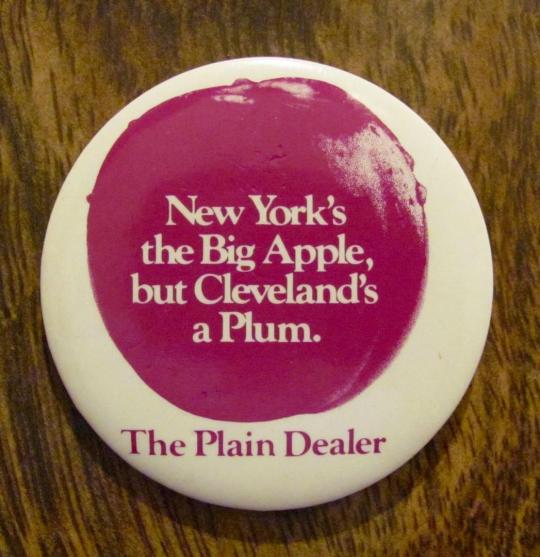
-------------------------------------
Give us a quick bio.
Born in Cleveland, 1981. We moved to the west side suburbs when I was six. My parents didn’t listen to much music, and I don’t have older siblings. So I didn’t really listen to music at all until I was in high school, and I didn’t listen to any of the grunge or ‘90s stuff that was popular. I got real into the Beatles when I was in ninth grade, and at some point I got the Velvet Underground’s first album from the library because I saw Andy Warhol’s name on the cover. I didn’t know anything about them, so that was a real shock. I probably first heard Iggy Pop via the Trainspotting soundtrack, and pretty soon after I started getting into punk and generally more obscure stuff. Now I listen to more electronic stuff, ambient stuff. I also like most anything that falls under the broad “post-punk” umbrella. I really hate “rama-lama ding-dong” rock and roll.
What came first – music or drawing interest?
Drawing. I was always drawing… I’ve been a semi-regular contributor to Mineshaft for many years, which is a small zine/journal that features a lot of underground comix related stuff, but also has a beatnik vibe and includes poetry and writing. I’ve done the odd thing here and there for other zines, but I don’t really fit in anywhere.
Don’t really fit it – I feel that phrase describes a lot of the best / more influential Ohio musicians / bands. Did you feel that kind of feeling about Peter as you researched and wrote the book?
Peter was well liked, and he knew a vast array of people. If anything, he fit in in too many situations. He was spread thin.
When you lived in Philly, did you get a sense of any kind of similar proto-punk scene / era in that town? I sometimes, perhaps jingoistically, think this particular kind of music is almost exclusively confined to the Rust Belt.
I lived in Philly for nearly 11 years. As far as the old scene there, they had Pure Hell. But back then, anybody who really wanted to do something like that would just move to NYC.
So, is there a moment in time that started you on a path towards wanting to dig into Cleveland’s proto-punk past like this?
It was just something I had a vague interest in, going back to when I first heard Pere Ubu. And then later learning about the electric eels, and starting to get a feeling that Cleveland had a lot more to offer than just the Dead Boys. The Rocket from the Tombs reunion got things going, and that’s when I first started to hear Laughner’s name. A few years later, a friend sent me a burned CD of the Take the Guitar Player for a Ride collection, and I started to get more interested in Peter specifically.
Despite any first wave punk fan’s excitement about a Laughner bio, this book is moreso a history of Cleveland, and trying to connect those odd underground, counterculture, or mythological connections that the Chamber of Commerce tends to ignor as the town’s import. Was there a moment where you realized this book needed to go a little wider than only telling the tales of Laughner and the bands of that era? (Not that there’s anything wrong with that!)
Very early on I realized that none of this would make sense or have any true meaning without the appropriate context. The activities of the early Cle punk scene need to be viewed in relation to what was going on in the city. I think this is just as true with NYC or London – these were very specific contexts, all tangled up in politics, crime, rent, television, and also the specifics of the more hippie-ish local countercultures that preceded each region. You’ve got Bowie and Warhol and all that, but in Cleveland you’ve also got Ghoulardi and d.a. levy. Mix that up with deindustrialization and a picture starts to form.
youtube
So when did you decide on doing this book? You’ve mentioned this was your first attempt at doing a full graphic novel – and boy, you went epic on it!
I did a short version of Peter’s story back when I was living in Philadelphia. But upon completing that version – which I now think of as a sketch – it became clear that there was a lot more to say and to investigate. I spent about a year just thinking about it, forming contacts with some people, and tracking down various reference materials like records, zines, books, etc. Then my wife got a new job at Cleveland State University, so we left Philly. Once I landed back in Cleveland I started working on the book in earnest.
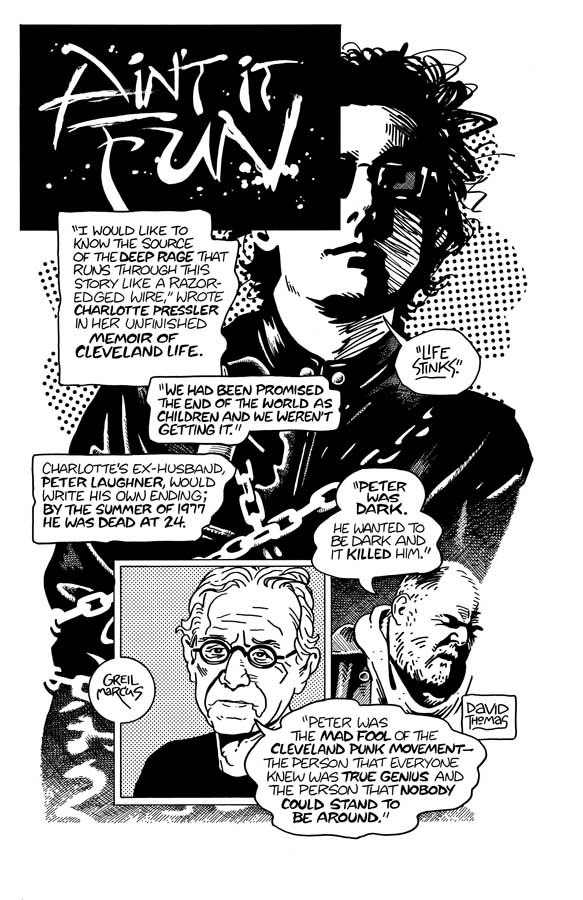
Page from Ain't It Fun -- all book images courtesy of the author.
By any chance was Greil Marcus’ book, Lipstick Traces (1989), an inspiration, as far as the “hidden history” factor, the trying to connect seemingly unconnected and lost historical footnotes into a path towards the culture’s future?
Yes. I read Lipstick Traces when I was around 19 or 20, and I’d never seen anything like it before. It really blew my mind, all the stuff about the Situationists and Dadaists and all that. Later on, I read Nick Tosches’ Dean Martin biography, Dino, and that was another mind blower. Another major influence is Iain Sinclair.
Ah Dino, another Ohio native. So, Laughner’s one-time partner, Charlotte Pressler’s book is mentioned, and I’ve seen it referenced and talked about for years – any inside word on if/when she might have that published?
Charlotte never wrote a book, though she did co-edit a book that collected the work of local poets. As far as her own writing, she’s done all manner of essays and poetry, and probably some academic writing that I’m not familiar with. As far as her completing “Those Were Different Times”— which was intended as a total of three essays— I’ve got some thoughts on that, but it’s not really my place to comment on it.
Pressler sounds like a very serious person in your book, as you say, she was kind of older than her years. But how was she to talk to?
Charlotte is serious, but she’s not dour. She’s got a sense of humor and she’s very curious about the world, always looking to learn new things. She’s an intellectual, and has a wide array of interests. We get along, we’re friends.
The fact that the town’s namesake, Moses Cleveland, left soon after his “discovery” and never came back – that’s like a template for how people envision a town like Cleveland: nice place to grow up, but you want to get out as soon as you’re legal. Even the musicians of the area might’ve agreed with that sentiment, even if many never left. Do you think that has changed?
I’m glad I left Cleveland, but I’m also glad I came back. First off, my family is here. Second, the cost of living is still reasonable. I don’t know how people live in New York. I never have any money. I’d make more money if I had a full-time job at McDonald’s. That’s not a joke, or me being self-deprecating. How do artists live in New York? How do they afford rent and 20 dollar packs of cigarettes? I’m just totally confused by the basic mechanics of this. So yeah, I’m in Cleveland. It’s not great, but what are my options? I can’t just go to Paris and fuck around like a bohemian. I would if I could.
In Ain't It Fun, you reveal that one of the seminal Cleveland scene dives, Pirate's Cove, was once a Rockerfeller warehouse – these kind of enlightening, almost comically perfect metaphors pop up every few pages. Not unlike the mythology that can sometimes arise in musician fandom, I wonder if these are metaphors we can mine, or just an obvious facts that the town drifted down from a center of industry to relative poverty.
“Metaphor” might be at too much of a remove. These facts, these landmarks — they create a complex of semiotics, a map, a framework. The city talks through its symbols and its landscape. If you submit to it and listen, it will tell you secrets. There is nothing metaphorical about this.
Is it a sign of privilege to look on destitution as inspiration? I’m guessing the sick drunks at Pirate’s Cove in 1975 weren’t thinking they were living in a rusty Paris of the ‘30s. Though I will say a thing I really loved about your book was that, for all its yearning and historical weaving, you still stick to facts and don’t seem to over-mythologize or put any gauze on the smog, like “Isn’t that so cool, man.” You capture the quiet and damp desperation of that era and Laughner’s milieu.
Poverty, decline, decay, entropy – these things are real. By aestheticizing them we are able to gain some control over them. And once you have control, you have the power to change things. This is not “slumming.” “Privilege” has nothing to do with it.
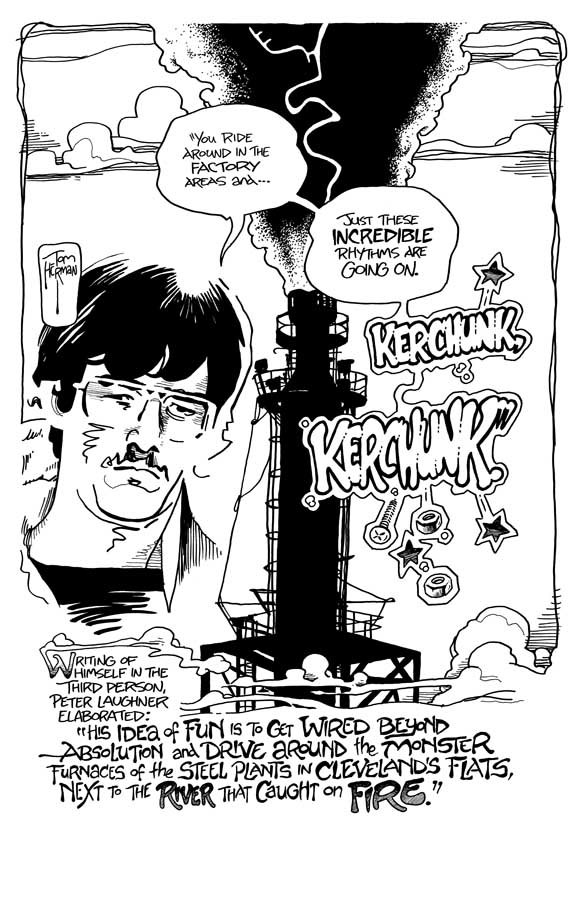
Page from Ain't It Fun
Do you know why the Terminal Tower (once the second tallest building in the world when it opened in 1928) was named that? It seems somewhat fatalistic, given the usual futurist positivism of the deco design era.
Terminal as in train terminal. It really pisses me off that there was once a time where you could go there and catch a train to Chicago or New York. It’s infuriating how this country dismantled its rail systems. And the Terminal Tower isn’t deco, but I think it is often confused with that style just by virtue of not being a gigantic rectangle. In that sense it does have more in common with a deco structure like the Chrysler building. Honestly, if you are looking for deco you might find more notable examples in Akron than you would Cleveland.
I notice a kind of – and bear with my lesser abilities to describe illustrative art – swirly style in your work that kind of aligns with art deco curves, maybe some Gustav Klimt…? In general, who were some illustrative inspirations for you early on?
That “swirly” style you describe is art nouveau. Deco came after that, and is more angular and clean. Additionally, a lot of underground comix guys were also poster artists, and there was often a nouveau influence in that psychedelic work – so there’s a bit of a thread there. As far as Klimt, I came to him kinda late, but I love him now.
The music of many northeast Ohio bands of that era has been generally tagged as “industrial” (the pre-dance industrial style, of course), cranky like the machinery of the sputtering factories in the Flats, etc… My guess is maybe the musicians were already finding used R'n'R instruments in thrift stores by that time, which would add a kind of layer of revision, turning old things into new sounds. Did you hear about of any of that? Or were there enough music stores around town? I know DEVO was already taking used instruments and refitting them; or electric eels using sheet metal and such to bang on…
I’m not a musician, so I don’t know anything about gear or stuff like that. I do know that Allen Ravenstine made field recordings in the Flats, and utilized them via his synthesizer. Frankly, I wish more of the Northeast Ohio bands had taken cues from Ubu and early Devo, because an “industrial” subculture definitely could have formed, like it did in England and San Francisco. But that never really happened here.
youtube
That kind of music was pretty popular on college radio and in a few clubs in Cleveland, though not many original bands with that sound arrived, aside from Nine Inch Nails who quickly took his act elsewhere… So in the book you mention local newsman, Dick Fealger. My memories of him are as a curmudgeon whose shtick was getting a little old by the time I was seeing him on the news, or his later opinion columns. Kinda your classic “Hey you kids, get off my lawn” style. You rightly paint him as a somewhat prescient reporter of the odd in his earlier days, though. I once had to go to a friend’s mother’s funeral, and in the next room in the funeral home was Dick Feagler’s funeral. I always regret not sneaking over and taking a peak into it to see who was there.
I like Feagler in the same way that I liked Andy Rooney on 60 Minutes. These were people that my grandparents liked. So I suppose my appreciation for Feagler is half nostalgia, half irony. I like cranks, grumps, letter-writers, street prophets. I like black coffee, donuts, diners, and blue plate specials – that’s Feagler’s world, the old newspaper world. Get up at 6 am and put your pants on, that kinda thing.
Yeah, I still found Feagler kinda funny, but like Jane Scott, while respect was always there, by the later ‘80s/’90s, both were set into almost caricatures who were kind of resting on their laurels.
Yeah, I remember seeing Jane at some random Grog Shop show back in the ‘90s, and I was kinda impressed. But no, she was never really cool. Jane was pure Cleveland, her career couldn't have happened anywhere else.
I remember seeing her sit right next to a huge house amp at the old Variety Theater for the entire duration of a Dead Kennedys show, taking notes for her review. Pretty impressive given her age at that point.
You also make a point of carving out an important space for The Damnation of Adam Blessing, a band that seems to get forgotten when discussing Cleveland’s pre-punk band gaggle. I find that interesting because in a way, they are the template for the way many Ohio bands don’t fit into any exact genre, and so often people don’t “get” them, or they’re forgotten later.
Damnation worked as a good local example for that whole psychedelic thing. They were very ‘60s. While the James Gang on the other hand, was more ‘70s— the cracks were starting to show with the ‘70s bands, they were harder and less utopian. Damnation feels more “Woodstock,” so they were useful to me in that regard.
I must add – for years I thought it was pronounced Laugh-ner, as in to laugh, ha ha, not knowing the Gaelic roots. Once I learned I was pronouncing it wrong, I still wanted to pronounce it like laughing, as it seemed to fit so darkly correct with how his life went, and Cleveland musicians’ love of bad puns and cheap comedians and such… Of course when I learned that it was an “ethnic” name, it made it that much more Cleveland.
Yeah, everybody says his name wrong. I used to too, and had to really force myself to start saying it as Lochner. But everybody says Pere Ubu wrong as well – it’s Pear Ubu.
I hate any desecration of any artwork, but I always loved the blowing up The Thinker statue story, as it seemed such a powerful metaphor of the strength of art, and Cleveland itself – the fact that The Thinker himself still sits there, right on top of the sliced-up and sweeping shards from the blast. It’s still there, right? And isn’t it true that there are like three more “official” Thinker statues in the world?
Yeah, I don’t condone what happened, but it is kinda cool. As a kid, the mutilated Thinker had a strong effect on me — I couldn’t have put it into words at the time, but I think it gave me a sense of the weight of history. It’s almost like a post-war artifact in Europe, something that is scarred. And yes, it’s still there outside the museum. And it’s a cast. I think there might be five official ones, but I’d have to look that up. If you are ever in Philadelphia, swing by the Rodin museum and check out The Gates of Hell.
I have only become a bigger fan of Laughner’s as the years pass. But there is something to the critique that perhaps he never really found his singular sound; that he was copping bits from Lou Reed and Dylan, and couldn’t keep a band together to save his life. And there was supposedly a feeling among some in the NYC scene that he was a bit of a carpetbagger.
youtube
Everybody has their influences, so Peter wasn’t in any way unique in that sense. I know he has a reputation for doing a lot of cover songs — which is true — but he also wrote a lot of originals, and there are some damn good ones which are still unreleased. “Under the Volcano” is just one such unheard song which I mention in my book, but there are others. As far as finding his own singular sound, he probably came closest to that with Friction. That group borrowed heavily from Television and Richard Hell, but also drew upon Richard Thompson and Fairport Convention. And when you think about it, those were really unlikely influences to juxtapose, and it created something original. Frustratingly though, Friction never achieved their full potential, as Peter was already losing it.
Yeah, Friction is kind of way up there with the “What if” bands… It’s interesting that for all his legend as a proto-punk figure, perhaps Laughner’s signature songs – Sylvia Plath” and “Baudelaire” – were gorgeous acoustic numbers. Though of course those early Pere Ubu songs were proto-punk and post-punk templates, somehow...
youtube
I honestly don’t know what happened with Ubu, as it is pretty distinct from Peter’s other work. Thomas isn’t really a musician, so we can only give him so much credit with how that sound developed. I honestly don’t know. There just must have been some sort of alchemy between the various players, and Thomas understood it and was able to encourage and guide it in the projects that followed over the years.
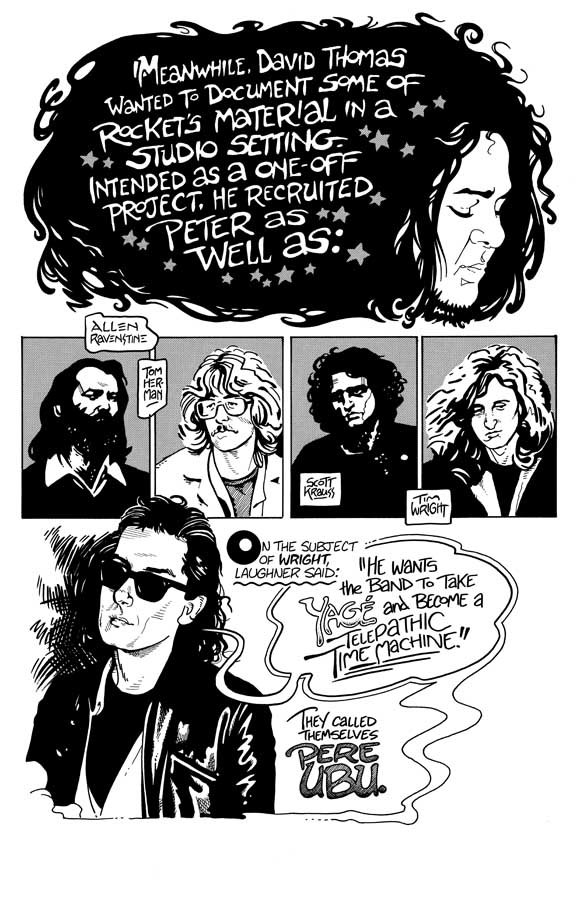
Page from Ain't It Fun
You also didn’t really detail Pere Ubu’s initial breakup – was there just not much to say?
Yeah, I think I mentioned it, but no, I didn’t really get into it. Pere Ubu is kind of a story unto themselves. But it might be worth mentioning here that Home and Garden was an interesting project that came out of that Ubu breakup. And Thomas also did some solo albums, but I’m not as familiar with those.
youtube
Yeah, I saw Home and Garden a few times way back, good stuff. You’ve mentioned to me that there were some people that didn’t want to talk to you for the book; and that people were very protective of Peter’s legacy and/or their friendship with him. To what do you attribute that?
It has everything to do with Peter’s early death. Some people are very protective of how Peter is remembered. And I think some people weren’t exposed to Peter’s dark side, so when they hear those descriptions of him it strikes them as untrue. I think Peter showed different sides of himself to different people.
I kind of felt as I was reading that you might say more about Harvey Pekar, as not only is he an interesting figure, but the most famous graphic novelist from Ohio, and I assume an inspiration of your’s.
Pekar’s great. Especially the magazine-size issues he was doing in the late ‘70s up through the ‘80s. It was important to me to include him in the book. But Pekar was a jazz guy, and that’s a whole other story, a whole other tangled web.
So, Balloonfest! Hilarious. I almost forgot about that. But I do remember Ted Stepien owning the short-lived Cleveland professional softball team; and for a promotion, they dropped softballs off the Terminal Tower, and if you caught one you won $1,000 or something. Do you recall that? It’s one of my favorite fucked-up Cleveland stories. Balls smashed car roofs, and cops immediately told people to run away.
youtube
Yeah, I’m aware of that baseball stunt. I generally try and stay away from anything even remotely related to professional sports teams — it gets talked about more than enough elsewhere. Oddly, I am interested in athletes who work alone, like Olympic skiers. I’m attracted to that solitary focus, where the athlete isn’t competing against other teams or players, but more competing with the limits of the human body, competing with what the physical world will allow and permit, that whole Herzog trip. I’m also interested in the Olympic Village, as this artificial space that mutates and moves across time and across continents.
As far as Balloonfest, I still watch that footage all the time. I use it as a meditation device. I’ll put it on along with Metal Machine Music and go into a trance.
youtube
A few years ago, as I am sure you are well aware, noted British punk historian Jon Savage put together a Soul Jazz Records comp of Cleveland proto-punk called Extermination Nights in the Sixth City. I grew up in Cleveland, lived in Columbus for awhile, and I never heard it called “the Sixth City.” Have you? If so, what does it refer to?
Nobody calls it that anymore. It’s an old nickname back from when Cleveland was literally the sixth largest city in the country.
I’d guess Ain’t It Fun was a tiring feat to accomplish. But do you have another book in the works? And if someone wanted to option Peter’s story for a movie, would you sign on? I personally dread rock biopics. They’re almost universally bad.
Yeah, I’ve got an idea for another book, but it’s too early to talk about that. As far as biopics, they are almost always bad, rock or otherwise. Rock documentaries are often pretty lousy too. A recent and major exception would be Todd Haynes’ Velvet Underground documentary, which is just goddamn brilliant. A film about Peter in that vein would be great— but there’s just no footage to work from. He didn’t have Warhol or Factory people following him around with a camera. So unless somebody like Jim Jarmusch comes calling, I won’t be signing off on movie rights any time soon.
Unless there is more you’d like to say, thanks, and good luck with the book and future ventures!
Stone Church Press has a lot of projects planned for 2024 and beyond, and I encourage anyone reading this to support small publishers. There is a lot of very exciting stuff going on, but you have to work a little to find it. Amazon, algorithms, big corporate publishers — they’re like this endless blanket of concrete that smothers and suffocates. But flowers have a way of popping up between the cracks.
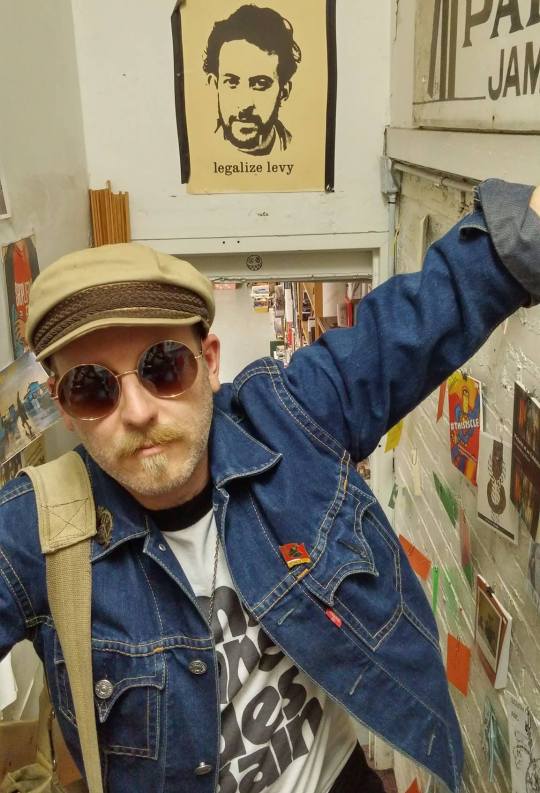
Aaron Lange, 2023 (Photo by Jake Kelly)
#punk#cleveland punk#velvet underground#peter laughner#pere ubu#protopunk#clevelandrocks#cleveland#devo#nycpunk#1970s rock#aint it fun#Ghoulardi#smog veil#guns n roses#ohio punk#ohio#punk rock#garage punk#biographies#eric davidson#lou reed#television#dead boys#rocket from the tombs#Youtube
17 notes
·
View notes
Note
I know you don’t really like Mick’s solo output, but what do you think about Keith’s?
I have mixed feelings about it. If I were to rank all of the Stones solo musical ventures, it would definitely be Charlie > Keith > Ronnie > Mick. Which, naturally, was also Keith’s opinion on the matter:
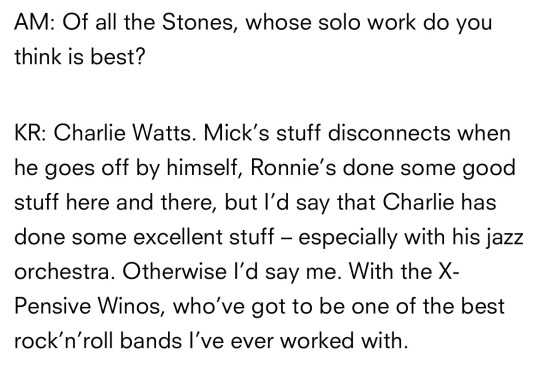
I’ve never been a fan of the Stones covers he did with the Winos, the tempos are always a mess and they drag.
As for the stuff that’s solely his, I think it’s a mixed bag. He’s genuinely very talented as a lyricist and I like the subject matter he tends to focus on, because it’s a lot about complicated and long term/older relationships, which isn’t necessarily a mainstay of mainstream rock. And I also enjoy his voice, he’s not Pavarotti or anything but he knows how to write for his own range and vocal quality.
That said, I feel like the music/band itself tends to be very hit or miss, and I actually tend to prefer the songs where it’s Charley Drayton playing drums instead of Steve, he’s got a lighter touch that suits Keith’s style better. I was at performance the Winos did at the Beacon Theater 2 years ago as part of Love Rocks NYC and for unexplained reasons (what I heard on the grapevine is that Steve and Charley had some kind of falling out related to Charley’s late wife) Charley wasn’t there. The choice of songs for the set kind of sucked and the replacement bass player was no good, but I don’t think that performance is probably representative of what they were like in their heyday in the late ‘80s/mid ‘90s. Still not thrilled with how much money I spent on a ticket for such a mediocre performance. Hozier and Mavis Staples were great, though.
His collaborations with Levon Helm and Tom Waits are both gorgeous and there’s some beautiful covers by him of Mingus and other artists floating around out there. It’s not *really* solo Keith, but for my money his best stuff in that realm will always be the songs he sings solo on the Stones records, particularly “Little T&A” from Tattoo You, “How Can I Stop” from Bridges to Babylon, “Thru and Thru” + “The Worst” from Voodoo Lounge, and “Slipping Away” from Steel Wheels. Also “Alteration Boogie”, even though nobody was ever kind enough to give us an official release.
Ironically, I listen to him most often when I’m exercising, especially running or doing boxing drills with a heavy bag. I will say that I have a special place in my heart for “Hate It When You Leave.” The lyrics are so him, of course, but it used to be a song that was perpetually on my playlist for nighttime runs in London, and I have many fond memories of listening to it while flying through the shittier parts of Shoreditch and Camden Town.
#I give him a pass on using ‘bitch’ as the female referent in so many of his songs#b/c I genuinely don’t think he means anything mysoginistic by it#and I do think if Anita or Patti told him they didn’t like that he wouldn’t do it#also he’s vastly more insulting to men in his songs than women#mick gets called a greedy fame hungry bastard#whereas#even when he’s getting screwed over by a woman he’s weirdly kind of into it#the rolling stones#keith richards#ask response#anonymous#I also love ‘Loosing My Touch’ from Forty Licks#but you can’t stream it#it’s only on YouTube pirated
7 notes
·
View notes
Text
Hajime Isayama Interview
Crunchyroll published an interview with Hajime Isayama last week from Anime NYC where he talks about the themes he wanted to explore in SnK, the end of the series, and his plans for the future (or not). It’s a fascinating interview, more for what he doesn’t say than what he does. He’s a master at avoiding direct questions. He’d make a brilliant politician! 😂
Perhaps the most interesting detail is that, although he has no immediate plans for spin off series, he did say that he has “something in mind” for Levi, though he doesn’t know whether he’ll write it or not.
Do you foresee any further spinoffs or do you feel you’ve told as much of the Attack on Titan story as you could?
Isayama: I have no plans right now.
Can we expect additional backstories for characters such as Hange and the original members of Squad Levi?
Isayama: Regarding Levi, I actually have something in my mind, but at the same time, I don’t know if I will be able to write that or not.
Can I ask what you mean by that?
Isayama: For example, I have imagined what the story of Levi would be in my mind, but at the same time, whether I am able to output it, that’s a whole other story because writing a manga is a really difficult task for me.
He also explained why there are no “direct romance themes” in the story.
Was there a reason you strayed from any direct romance themes within the Attack on Titan story?
Isayama: Number one, it was embarrassing to me to write stories about love between characters. The other reason is that if I continued to go into those kinds of tangent stories, we might lose focus on the immediate main plot of the story. So I wasn’t really motivated to go in that direction.
It’s kinda hilarious that he has no qualms about writing pretty extreme body horror, but he’s embarrassed by a bit of romance 😅
You can read the whole interview on Crunchyroll here: Attack on Titan Creator Hajime Isayama Reflects on the Series’ Ending, Game of Thrones and More.
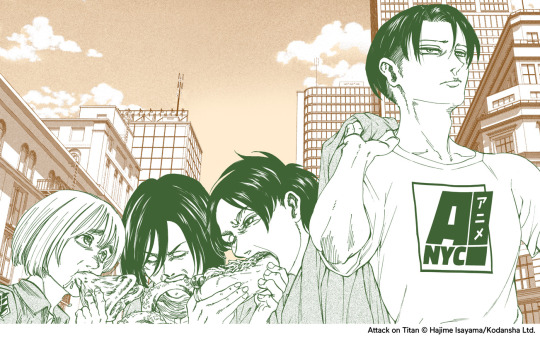
65 notes
·
View notes
Text
Atlanta ranks 143rd in population density among U.S. cities & that’s not good
The common misperception that Atlanta has gotten ‘too dense’ is about cars, not people.
If you go to Wikipedia’s List of United States cities by population and sort the chart of cities (with a population of at least 100,000) by their density, the City of Atlanta comes in at number 143, just underneath Visalia, CA and Sterling Heights, MI.

That’s a startlingly low level of of people-per-square mile for a major city -- and yes, these stats are about cities proper, not metro areas.
[BTW, I output the Wikipedia table to a spreadsheet program to be able to number the rows in the density sorting.]
This is something that plays directly into the choices we have for getting around Atlanta, including the fact that far too few people here have good access to transit as an alternative to driving.
For instance, if we want to have a city where expansion of rail makes more economic sense, we have to dense the heck up so that we can supply rail with riders. Same deal if we want to create more walkability, more foot traffic for neighborhood businesses, and de-center cars in our city. Dense up.
Buses are great. I love them and ride them weekly. But we could use more rail to compliment the system. The bottom line: rail is more expensive to operate than buses are. To make it cost-effective, we need higher passenger demand, which means (among other things) a higher density of people near transit stops.
I know some of you are thinking: "but we're already too dense in Atlanta; I can tell because car traffic is awful."
Nope. The fact that so many are dependent on cars is an indicator that we're not supporting transit well enough, with density and urban design, for it to carry more people. It also indicates we’ve got too much parking: a study of transit systems points to the availability of cheap or free parking as the biggest contributor to reduced ridership.

We're not full of people in Atlanta. The statistics show the opposite. What we're too full of is car-centric, suburban-type places that don’t prioritize walking and biking and transit, thus generating a glut of car trips and and outsized demand for parking spaces.
Atlanta doesn't have to reach for NYC levels of urban density (they've got 29,298 people per square mile, compared to our 3,686). But we do have to reach higher than Sterling Heights.
------
For some great reading on how Atlanta’s problematic, low-ish density was very much designed, read this post on the Atlanta Studies site called “Atlanta’s War on Density.” It details the intentional land-use changes that formed our suburban-style city density.
35 notes
·
View notes
Note
i just wanted to say how much i LOVED your sydcarmy nyc fic!!
don’t get me wrong established relationships fics are great but pining/yearning carmy?!? UNREAL esp when he just wanted to reach out to her and his conversation with nat at the end!! do you have plans for any more or any headcanons of what they’re like then
thank you so much!
so far i’ve written three sydcarmy fics and i’m partial to pining/longing (from both of them) just bc of who these characters are and my belief that they wouldn’t/can’t get together easily or quickly.
they really both have to burn inside. it’s gotta be dramatic and it’s gotta come to a head in a really intense, explosive way.
to answer your question i have a few headcannon ideas but i’m honestly not sure when/if they’ll come to fruition as i have other writing projects that require my focus/creative output, etc.
so we’ll see.
thankfully, there’s so many great writers in this fandom and it seems even more coming out of the woodwork after season 2 so i think we’ll have a lot to read and choose from in general which is exciting!!!
16 notes
·
View notes
Text
To Improve Your Company's Curb Appeal in NYC, Select the Best Sign and Awning Company

Improve Your Company's Curb Appeal in NYC, Select the Best Sign and Awning Company
It's critical for businesses to differentiate themselves from the competition in a busy metropolis like New York. Investing in premium signs and awnings that improve your company's curb appeal and increase its visibility to potential clients is one efficient approach to do this. Nevertheless, it can be difficult to select the best sign and awning company for your business in NYC because there are so many of them. In this article, we'll look at some advice for selecting the best NYC sign and awning company as well as how TruArt Sign Co. can support the growth of your company.
Knowledge and Skill
It's critical to choose a sign and awning firm in NYC with experience and knowledge of the sector. You want a business that can produce long-lasting, high-quality signs and awnings while also having the expertise to comprehend the particular difficulties of operating in a metropolis like New York.
Personalization Choices
Since every business is different, so too should your awnings and signs be. Choose a sign and awning provider who can collaborate with you to develop a design that fits the particular requirements and objectives of your organization and provides customizable choices.
Superior materials
Selecting a company that employs premium materials will ensure that your signs and awnings survive for many years to come. Your signs and awnings are a representation of your business. Seek for a provider that guarantees their work and employs weather-resistant, long-lasting materials.
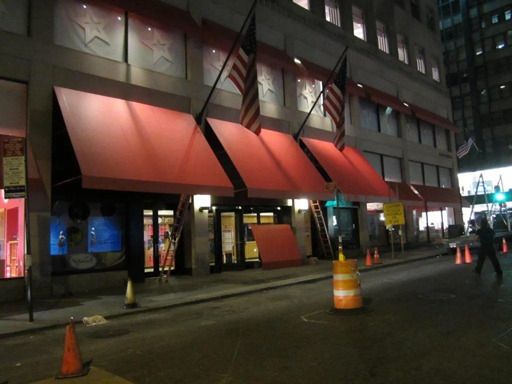
Outstanding Client Care
Ultimately, it's critical to select a sign and awning company in NYC that provides top-notch customer service. You want a business that will listen to your requirements and worries, and that will collaborate with you to make sure you're satisfied with the finished output.
To sum up
Selecting the best sign and awning company in NYC is crucial if you want to improve the curb appeal of your business and draw in more clients. We at TruArt Sign Co. have the knowledge, know-how, and dedication to client satisfaction you require to be successful. To guarantee that you receive the signs and awnings that fulfill your particular demands and objectives, we provide a large variety of customisation possibilities, premium materials, and first-rate customer service. To find out how we can support the success of your company, get in touch with us right now.
#Sign & Awning Company NYC#New York City Signs & Awnings#Sign Installation NYC#Best New York City Sign Company
2 notes
·
View notes
Text
THE LIGHT SIDE OF THE MOON: SCARLETT TAYLOR'S VEIL

All Photo Credits to Helen Elizondo. Essay by Tejas Desai.
The New Wei is proud to introduce a feature series on bold, dynamic artists who push the boundaries of what's possible and deliver a unique life vision.
Our first ever feature is musician Scarlett Taylor. The 23 year old phenom (it's her birthday today, btw!) is a groundbreaking auteur who today 2/1/24 released her second album HALLOWS, a live remastered version of her spectacular debut demo album Veil. She is also playing a show tonight at the renowned NYC music venue Pianos at 7pm:
The following essay examines her music, motivations, and milieu, from her beginnings in quiet but dynamic Lancaster, Pennsylvania to her breakout releases over the past year, when she has come into her own in the greatest city on Earth. You won't find musical biography or criticism this in-depth in any publication outside of possibly Rolling Stone.
So keep it right here on The New Wei, people!

While Olivia Rodrigo croons about relationship revenge and Billie Eilish belts movie soundtracks, another young singer is creating a different path altogether. Her name is Scarlett Taylor, she’s about to turn 23 and she is churning out a more thematically complex oeuvre than her contemporaries.
The 13 songs of her debut demo album Veil are rich in sound and meaning, from the abstract “Love Where the Soul’s At,” dedicated to the decapitated descriptions of Aphrodite in Greek art, to “The Night Beast,” where Taylor evokes “howling at the moon,” to the electronic-heavy “Déjà vu” and the doppelganger-themed “Shadow Talking.” The themes include her own concepts like the veil, silhouette and perfect timing, along with timeless ones like loneliness, fate and loss.
These tracks were released biweekly from her 22nd birthday on February 1, 2023, to the album’s official release date on August 1, 2023. 8 remastered versions will be available on her 23rd birthday, February 1st, 2024, on a live album called HALLOWS.
Before starting this steady output, Ms. Taylor was not performing or creating music regularly—previously she had only released one song called “Clementine,” which she has since disowned and taken off Spotify, claiming it “was not her own” because someone else produced it.
By contrast, Ms. Taylor has controlled every aspect of Veil’s creation and marketing. She makes her own merch, which includes sewing shirts, drawing posters, and creating pins. She performs regularly and creates art daily. This output, apparently, has been personal and artistic therapy for Ms. Taylor, who described the process of creating and releasing as “transformative like the cycles of the moon.” In fact, the biweekly releases are timed to coincide with the full moon and new moon, important symbols for her complex life philosophy.
I first officially met Scarlett Taylor at The Purgatory in Bushwick, Brooklyn, where she was scheduled to open for another up-and-coming singer, Taylor Mecca. Upon arriving, I spotted Ms. Taylor, a tall blonde wearing a trench coat with a guitar strung around her shoulder. I introduced myself. She was so excited I had come to see her play that she gifted me a button-down t-shirt she had sewn from scratch that exemplified the themes of her album: the veil and the silhouette.
On the other side of a flower pattern, the t-shirt stated: “Slipping into the Silhouette of this Veil.” According to Ms. Taylor, the veil represents the parts of us that others cannot see or that we hide, whereas the silhouette symbolizes those that are inevitably public. It seems that in her construction the truth behind the complexity of any human is a balance between those two elements, and perhaps her music tries to capture the space between that divide. Yet the meaning of her work goes well beyond this dichotomy because she describes her songs as “Witch Music,” which is also a title of one of the tracks.
To understand Ms. Taylor’s thinking and aesthetic intent more fully, it might make sense to delve into her background. Her father is Chad Taylor, long-time guitarist of the alternative rock band Live, which released 9 albums over 25 years and experienced some commercial success in the 1990s. Her mother is a yoga teacher. She was born and grew up in Lancaster, Pennsylvania, a distinct mixture of extremely progressive and conservative lifestyles. Ms. Taylor says she was raised in a loving home, where her parents cultivated both her musical and spiritual development. She attended private schools, including Montessori. She has two sisters, both of whom are artists of various types, though neither are musicians.
From the beginning, her parents had an enormous influence on her life path. When her father was home from tours, music would fill the house, and like her mother, she was trained in yoga, becoming a teacher herself. When it was time to consider colleges, she decided to apply to only one school, the Clive Davis School of Music at NYU, which she has attended for the past three years and from which she graduated early in December 2023. If she had not gained acceptance, she says she would have continued to live at her parents’ home in Lancaster, teaching yoga, perhaps working a day job, and creating her music.
In Lancaster, witches, mediums, and doulas filled her social life, and she says that she is fortunate to have been surrounded by so many spiritual women, who taught her to read tarot cards, to release and manifest, to understand the meaning behind the intersection of stars and moons. This is why she celebrates witches, who she says are light workers who inform people how to live a more joyful and loving life through rituals and serving magical elements.
It seems Ms. Taylor’s music is a means of performing this work within herself. Her life has changed immeasurably for the better since she started releasing her music. She is far more spiritually and emotionally positive, and it has unfurled an enormous social life in New York City for her that revolves around music and art.

I categorized my first meeting with Ms. Taylor as “official” because I had encountered her once before. Earlier that summer, I had attended a concert at a converted garage in Bushwick called The Shop. I was there to see another rising star, model-cum-rocker Bec Lauder, who had described it on Instagram as a “secret little show.” I needed to click on a link, enter a password (that I gleaned from another spotlighted band’s post) and pay $8 via Venmo or cash at the door. Being old school and middle-aged, I think I was the only one to pay cash, and Ale, one of the organizers who lived upstairs, needed to go to his apartment to get change for me.
I had come half an hour late, fashionably, but I still needed to wait another hour to see the first band play. During that time, I drank a Bud, included in the price, and met some of The Wedding Planners, the group that organized the event. Jacob Geoffrey and Ale, of the band Ale’s Love Letters, are both musicians themselves, while Maddie, one of several non-musicians, is a philosophy PhD. student, part-time painter, and editor of A Zine.
Several copies of this publication were stacked up in the corner of the garage, and their content, a mixture of poetry, grotesque drawings, and trauma-based prose, seemed to correspond to the shadow work of Ms. Taylor’s musical imaginings. She was there as well—we exchanged a smile—but I never actually met her that night.
The space was filled with art. It was one of a series of monthly concerts that focused on different themes. That evening it was “Magic Night”—participants were urged by email to “dress magically” and there was a magician on-site doing tricks—whereas other themes included “Beach Night,” “Art Night,” and “Alien Night.”
The crowd consisted of young 20 somethings, mostly seniors in college or recent graduates. The initial attendees seemed to know each other, and I was treated with a mixture of fear and wonder.
According to Ms. Taylor, the Wedding Planners formed from a text thread created by Mr. Geoffrey, a recent NYU grad himself. There’s no individual photography allowed at Wedding Planner events (there usually is a designated photographer, however), meaning it’s one of the rare contemporary concerts where a million iPhones aren’t held up to a performer’s face. Ms. Taylor says this radiates a different energy, and it’s meant to form a safe space with no judgment for performers and participants alike.
Concerts are essentially ceremonies, according to Ms. Taylor, and one of the most intriguing aspects of the Wedding Planners concerts is that they perform mock weddings during the night. After their set, the first act throws a bouquet into the crowd. Whoever catches it must propose to someone by the end of the night—it could be a stranger, their friend, a crush, whoever. One of the Wedding Planners officiates, and sometimes this is Ms. Taylor. Otherwise, the night has a few acts, and a DJ takes care of the rest.
Among this friend’s group are an endless number of young musicians, some of whom are Wedding Planners, others not. A vastly truncated list includes Jacob, Ale and Bec, Stevie Bill and Juliet Ivy, Ty Lorenzo, Khaliko and Vanessa Camacho. But for me, Ms. Taylor’s music stands out as worth exploring in depth.
Throughout Veil, there’s a tension between opposing forces—the veil and silhouette, nature and man, love and sex, spirit and body, beast and machine. The narrator struggles within herself to understand the tensions between these elements, and ultimately, concludes that a greater force might be at work in the orientations of her life.
The first quarter of Veil focuses on the individual’s relationship with the cosmos in a mechanized world, beginning with its title track, which will be renamed “Perfect Timing” on the live HALLOWS album. Immediately the singer slips into the silhouette of this veil, and the progression of the song suggests confusion and transformation. In “Internet,” or “The Machine” on HALLOWS, the singer laments a mechanized world where “machines talk to robots” and regrets “growing up online.” “Illusion” finds the narrator defiant that she “won’t quit howling at the moon,” or give up trying to understand the universe despite our man-made reality.
Then we are thrust into a dream and dance sequence of rock rhythms and electronic beats. “New Year’s Day,” a cryptic diatribe, flows into “Déjà vu,” where a dreamy, naive girl meets her lover in the cosmos, and concludes with a desperate wish for reciprocation. “Witch Music,” defining the album’s core vision, serves as its pivot, interrupting its pensiveness with a clubby dance anthem.
The third quarter of Veil explores decadent nights, stormy relationships and insecure feelings. “Tooth Decay” evokes the image of a cigarette on an ashtray and transitions to foreplay and one-night stands. “Love’s Where the Soul’s At” explores the tension between body and spirit, as a woman wonders why she’s loved, and whether her lover is placing her on a pedestal for the wrong reasons. “I don’t want to be like a god to you,” she insists. “I wish my body was gone.” But she keeps repeating to herself, “sex means more” than love, perhaps trying to convince herself that it does.
“The Labyrinth is Bored” uses the metaphor of a bullfight to explore the power dynamics of entanglements and break ups. “Deep grief, time thief. I’m forever mad at the matador. Wrap my skin in red, the victory is yours,” she says, apparently giving into her lover’s worship, whereas in “Night Beast,” the narrator feels guilt “in hindsight” for her previous behavior. “I’ve been the night beast, howling at the moon. A lover to you, destined and doomed.”
The album’s final quarter brings us back to the individual’s battle within herself—the tension between her internal confusion and external savvy. “Slide Down the Wall” evokes the familiar feeling of finally having a relationship you’ve always wanted but now feel you don’t deserve: “You told me you’d be by my side. You are what I’ve been looking for. Loving you feels so easy. Loving you feels like changing seasons. Loving a fool. Loving a fool.” Despite having what she wants, the narrator is still dissatisfied, and wonders if a human relationship is enough to satisfy her need for personal evolution.
The next song, “Where the Shadow’s Play,” references a tempered moon and evokes a lover’s gloom about loneliness and loss. “Meet me where the shadow’s play. My darling’s gone in the afternoon. Sun’s pouring into my moon.” Here the narrator confronts her doppelganger and ponders light and darkness as she considers her true path.
In the final song, “Shadow Talking,” the narrator wakes up on a Monday morning, and considers her relationship-free reality. “My life is scary at night,” she laments. “Lately I’ve been running from my shadows.” Her doctor, in lieu of her lover, doesn’t talk to her and only prescribes her pills. “I’ll wait for the dawn, for that’s the only thing to do,” she concludes. Having struggled with nature and man, love and sex, and now alone to battle within herself yet again, she appears to be at an uneasy truce with the fact that things will unfurl as they will—and perhaps according to a greater ordinance.

The moon themes and investigation of individual identity and mental health, along with the essential conflicts of the time in our “civilized” era, call to mind The Pink Floyd album The Dark Side of the Moon, released exactly 50 years earlier in 1973. Ms. Taylor claims this is mostly coincidental (although, she continuously notes, “there are no coincidences”). However, she has listened to it, as it was grandfather’s favorite album and her singing teacher at NYU, Machan Taylor, is the voice on The Dark Side of the Moon. So, she says there is a lot of “collision” with the album. but she hasn’t spent an exorbitant amount of time with it.
But it’s difficult to completely divorce this album from its predecessor. Like The Dark Side of the Moon, Veil is both a studio album and a concept album. It experiments with sound and is creative in the musical and recording process. In Ms. Taylor’s case, she uses stock logic plugins to alter her voice on certain songs. Just as Pink Floyd’s album was mixed at the famed Abbey Road, the tracks on Veil were mixed in the same studio as where Survivor’s Eye of the Tiger was recorded. The Beastie Boys donated this studio to NYU, and band Phoenix provided its EQ.
Veil is more electronic than rock and it has a decidedly female spin. But like The Dark Side of the Moon, its songs blend into each other in a way that add progressive meaning. While Pink Floyd often wrote their songs as they were touring, in Ms. Taylor’s case, the songs were released as she was creating them.
Yet, she insists, her major influences are more modern, including Maggie Rogers, Grammy-nominated alternative singer who graduated from Clive, got her master’s at Harvard, and shares some of Ms. Taylor’s academic interests; Taylor Swift; Phoebe Bridgers; Bjork; and Mitski. Her father, of course, was a musician with Live, and she was able to go to rock concerts at a very young age, a privilege most aspiring musicians don’t have.
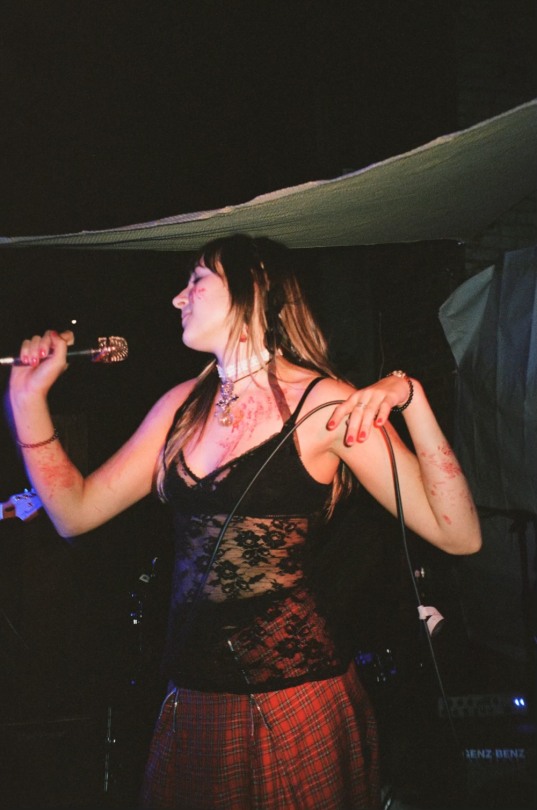
Ms. Taylor’s singing in Veil has a raw and caustic quality, so I was a bit surprised when she informed me that she has been trained professionally from a young age. Her crooning as a toddler led her parents to send her to singing lessons. She quickly graduated to musical theater, then opera, and competed in all-girls choir competitions in middle school.
While in high school, she always assumed she would take a more classical route, since he had always sung Soprano 1 opera music at her local college with their Artist-in-Residence who was a Metropolitan Opera singer. Yet this training, she says, prepared her well for rock music, which tends to be verbose, what she called an “Evanescence vibe.”
Why she now exclusively creates rock and electronic music, rather than continuing with opera, has to do with personal vision and control. With opera, she was a hired hand, but with rock, she can create what she wants. She can write her own lyrics and experiment with sounds. While the live album, HALLOWS, was not recorded by her, she did control all aspects of Veil, making it a true auteur work.
Yet, her auteur vision is matched by a strong fatalistic quality. In Ms. Taylor’s life philosophy, there is a sense that the future has already been written, even understood by those who have studied it for centuries, and she even says that we, as individuals, know more about the future than we let on, because we already plan for it on a daily, weekly, monthly, and even yearly basis.
This duality is present in yet another concept of hers, “Perfect Timing.” In fact, she read an essay about this phenomenon at Lincoln Center a week before our first interview at an event called Truth to Power Café. In the essay she describes her sister’s metaphor of the lemon tree. Because it is a perennial plant, it continues to bloom without water or resources, and it can take between 15-70 years to grow a lemon even after planting the seed. You can either wait for the lemon to bloom with joy or fear, because either way the blooming is predestined, but you do not know it’s timing. Therefore, it’s the attitude of the bearer of fruit that is essential—everything else is prewritten without necessary knowledge.
Ms. Taylor takes this joyful and positive attitude wherever she goes: to her volunteer tutoring, to her classes, to her paid internship at a major record label, where she conducts research and writes reviews on which artists the label should sign, and reads tarot cards to anyone who is interested; and at her part-time job, where she studies the intersection of the stars and moons when not folding jeans.
She intends to stay in New York City, bolstered by her large, and ever growing, circle of friends in the burgeoning indie music scene here. Her goal is to create 2 albums per year for the next five years. When I asked her where she sees herself in that time, she was unequivocal that she would be able to make a living from her songs by then. “I believe it, so it will happen,” she proclaimed, despite the reality that she has only earned a few cents on Spotify for her songs so far.
But she is also practical. At this point, she does not plan to pursue advanced education, so she knows she will need a day job in the interim, and she is trying to gain positions at the record label or in the fashion industry, believing that her NYU degree will give her a leg up in this quest. But her music and art will always come first for Ms. Taylor.
About the Author:
Tejas Desai is an Amazon #1 Bestselling, multiple award-winning author of two dynamic book series: The Brotherhood Chronicle international crime trilogy (The Brotherhood, The Run and Hide, The Dance Towards Death) and The Human Tragedy literary series (Good Americans, the unpublished Bad Americans). He is the founder of The New Wei Literary Arts Movement and runs its associated Salons. He is a graduate of Wesleyan University, attended the University of Oxford, holds two Masters degrees from CUNY-Queens College. While he travels frequently, he works as a Supervising Librarian at one of the busiest public libraries in New York City, where he was born, raised, and of course, still lives.

#contemporary music#indie music#musician#Scarlett Taylor#the new wei#music#electronic music#pink floyd#the dark side of the moon#veil#hallows#witches#tejas desai#auteur#maggie rogers#phoebe bridgers#mitski#Taylor swift#lancaster#bushwick#brooklyn#photography#artists on tumblr#female artists#artists#women artists#authors#shadow work#therapy#light worker
2 notes
·
View notes
Text




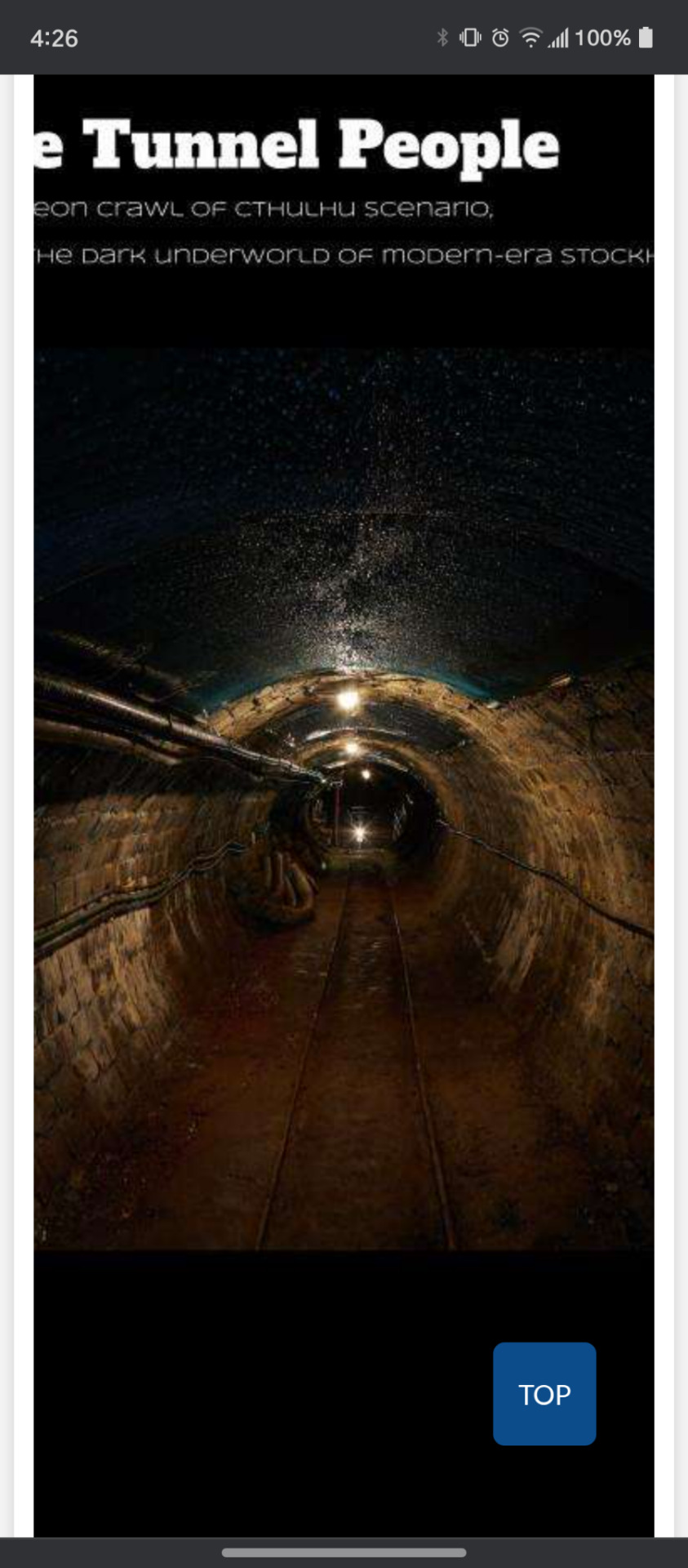

Pics:
1 & 2. The astronomer turned writer himself. Traveling - thru some twilit zone - into the darkness of the human soul. And, raising the fear therein...
3 & 4. Lovecraftian currency!! The easy way to corrupt - & consume - the all too weak human soul!
5 & 6. Following the slick slime trails, found deep beneath all cities's guts, leads (all worshippers of darkness) into their own mouth of madness...
1907: Astronomer in Residence.
Life: In January, Lovecraft lectured the Boys Club of the 1st Baptist Church on general astronomy.
Otherwise, HPL is busy with school work, his astronomical observations, writing a newspaper column & in his Jellygraphing a "special" for his few friends.
He has little time for fiction. Or, so it seems...
Output:
1. "The Picture" is a short horror story that was never published & which now seems to no longer exists.
It's plot is about a Parisian artist painting what he considers to be the ultimate embodiment of evil itself.
Sadly, the artist is later found - murdered to death!
It seems that, in his death struggle, the finished painting was almost totally destroyed.
Only a small corner of the canvas still remains...
On it, is a picture of the bloody claw that killed the artist!!
Note: Only a description of this tale is known to survive. The story itself is thought to be lost to history.
But, even this small bit of plot, shows off HPL's growth as a writer.
Previously, Howard's work relied heavily on Poe as a model.
Now, Lovecraft's tales carried the mark of writer Robert W. Chambers. And, HPL was heavily influenced by Chambers's story "The Yellow Sign."
Howard loved the work's archaic style, it's artistic atmosphere & the exotic setting.
Howard's "Picture" is now seen as a precursor to his later horror short "Pickman's Model."
Even it's title was later reused by Lovecraft, as "The Picture in the House"...
"The Picture" might be part of the early tales that HPL considered unreadable & which he destroyed...
2. "Celestial Objects For All" describes itself as an "Easy Guide to observing the skies with Opera or Field Glasses."
I could only find a single mention of this publication. And, it's Howard's 'dismissal' of our solar system's last 2 planets.
"Both", he wrote, "are visible as faint stars in opera glasses, ... their study seldom repays the observer."
9 years later, Lovecraft would opine that Uranus was likely "a hot & molten semi-sun."
We now know how close his remark really was.
Ice giants are mostly composed of hot liquid water, methane & ammonia.
Their atmosphere is full of hydrogen, helium & trace amounts of methane.
I've only heard of the planet Jupiter as being considered a proto-sun. Which is what most of us saw in "2010: The Year We Make Contact."
Note: HPL would remain interested in astronomy til his final days.
Even being able to visit NYC's Hayden Planetarium twice since it 1st opened in 1935.
Quotes:
1. Howard, on his scientific interest, "My grandma... was a lover of astronomy... And, it is to her obsolete collection of... books (on space), that I owe my affection for (the) celestial..."
2. HPL, on astronomy, "How trivial seem the rays of a (street) lamp, to him who is (used) to looking upon... suns & worlds."
3. Lovecraft, on journalism, "I was a great reformer... & had... ideas about uplifting the masses."
4. HPL, on friendships, "I believed in equality then &... invited a... bright Swedish boy (home) despite maternal protest."
2 notes
·
View notes
Text
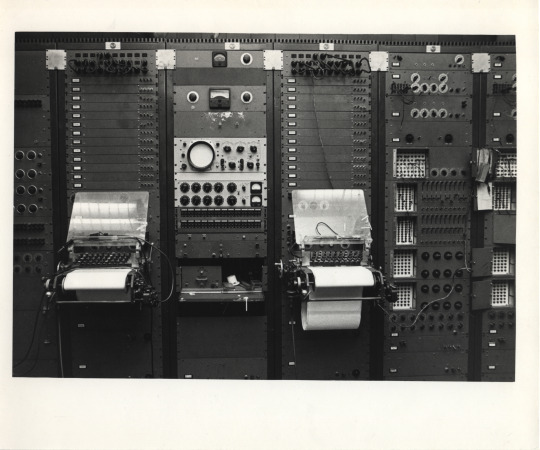



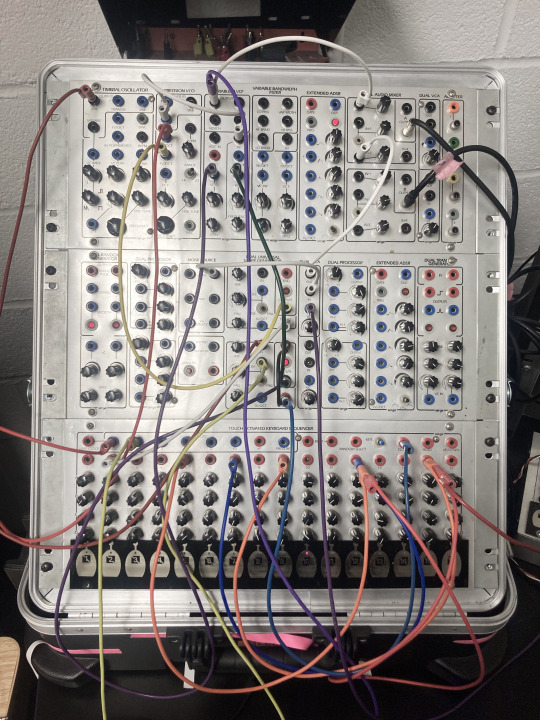
State Music — Residency at Columbia University / Computer Music Center
I spent five weeks in NYC between March and April 2023. It was a fantastic opportunity to work at the Computer Music Center in New York. The CMC is the first electronic music studio in the USA and Seth Cluett was kind enough to let me continue my research in the best conditions.
During this stay I was able to compose two new pieces for my forthcoming debut album State Music. The first was recorded in Studio 324 on two very early versions of Buchla and Serge analogue modular systems and two Bode frequency shifters. The process was similar to what I had done at EMS Stockholm, Radio Belgrade, KSYME Athens and Willem Twee Studio in Den Bosch. I tried to adapt to the machines installed in the studio, tested a lot of patches and recorded many hours of textures, accidents and other sonic events using a variety of techniques. The editing, collaging, layering and mixing was done later in my studio. I just followed one rule. Don't use the same recording twice. No loops, nothing like that.
The second composition was recorded in Jace Clayton's office. Why? Because the RCA Mark II, considered one of the first music synthesizers ever, still sits in that room. The synth has been out of order since 1976, when someone broke into the Prentis Hall building and vandalised the machine. But I decided to make use of it anyway. I opened one of the office windows to let sounds from the city into the room and recorded the tiny vibrations caused by street noise with a geophone magnetised to the synthesizer. In this way the synthesiser essentially acted as a loudspeaker. A cheap recorder was placed near the window. Two wide cardioid microphones were placed in the middle of the room for a high quality recording. Most of the time I sit in front of the synthesizer and do nothing but listen, and every now and then I flip a switch, turn a potentiometer or unplug a patch cable to activate the acoustic space of the office and make the metal frame of the machine vibrate.
It was an amazing moment. I've been working on the State Music project since 2018. I realised that being in that room with that silent machine felt like achieving something. My understanding of electronic music history is much deeper. The links between early synthesizers and the military industry are now much clearer to me. State music? Corporate music? I don't know and it doesn't matter.
Here's an anecdote from The Enabling Instrument: Milton Babbitt and the RCA Synthesizer" a paper by Martin Brody.
When the Mark-I appeared in 1955, it was listed in the RCA Acoustics Laboratory inventory with a proud comparison: The synthesiser was 'second only to the Typhoon rocket simulator as the largest single assembly to come out of the David Sarnoff Research Center'. [Although the Mark-I was built to recreate a peaceful expression of human subjectivity rather than to obliterate a hostile and remote man-machine, its input/output components were as indifferent to the workings of the psyche as an anti-aircraft predictor.As Harry Olson recalled, to test their new machine, Olson and Belar followed Seashore's playbook of analysing past performances. The goal was not to expose the musical mind, but to simulate the sounds of acoustic instruments and human performers with the utmost precision.
I would like to thank Seth Cluett, Anna Meadors, Jace Clayton and Nick Patterson for their help.
#large#RCA#STS Serge synthesizer#Buchla 100#RCA Mark II#Victor#Computer music center#Seth Cluett#Martin Brody#Milton Babbit#Vladimir Ussachevsky
4 notes
·
View notes
Text
Best Studios for Music Recording Bronx NYC in 2023
Introduction
When it comes to recording music, finding the right studio is crucial for artists looking to create high-quality tracks that resonate with their audience. In the vibrant musical landscape of Bronx, New York City, there are numerous recording studios that offer top-notch facilities and services. In this article, we will explore the best studios for music recording in the Bronx, NYC, that aspiring artists can consider booking in 2023.
The Musical Heritage of Bronx, NYC
Before delving into the best recording studios, it is essential to understand the musical heritage of Bronx, NYC. The borough has a rich history of influencing various music genres, especially hip-hop, which is said to have originated in the Bronx. Renowned artists like Ace Frehley, Jennifer Lopez, Luther Vandross, A Boogie wit da Hoodie, and many others hail from this region, solidifying its position as a musical powerhouse.
Criteria for Selecting the Best Recording Studios
Selecting the right recording studio involves considering several crucial factors that contribute to the overall quality of music production. Some of the key criteria include:
3.1 State-of-the-Art Equipment
The best recording studios in Bronx, NYC, boast state-of-the-art equipment that ensures the highest quality sound production. From top-notch microphones and audio interfaces to high-end speakers and mixing consoles, the equipment used significantly influences the final output of the recorded music.
3.2 Experienced Engineers and Producers
Having experienced engineers and producers is paramount for a recording studio's success. These professionals bring their expertise and creativity to the table, helping artists achieve their desired sound and capturing their unique musical expression.
3.3 Reputation and Clientele
A recording studio's reputation and clientele speak volumes about its capabilities. Studios that have worked with well-known artists and delivered successful projects are likely to provide exceptional services to new clients as well.
3.4 Sound Quality and Acoustics
Superior sound quality and excellent acoustics are critical for recording studios. Studios with well-designed recording rooms and soundproofing ensure that artists can focus on their music without any distractions.
3.5 Rates and Packages
Recording studio rates can vary significantly, and artists must consider their budget while selecting a studio. The best studios offer transparent pricing and flexible packages catering to different artists' needs.
4.0 The Top Recording Studios in Bronx, NYC
Now that we understand the essential criteria, let's explore the top recording studios in Bronx, NYC, for 2023:
4.1 Reach Reality Studios NYC
Address: Mount Haven, New York City (East 138th St & 3rd Ave)
Website: https://www.reachrealitystudios.com
Reach Reality Studios NYC - Bronx Home Page Bronx
Reach Reality Studios NYC
The most unique recording studio experience with our high quality equipment.
Book Now
Experience top-tier music production and mastering at Reach Reality Studios NYC Located in Mount Haven, New York City (East 138th St & 3rd Ave).
Our meticulously designed Raven and Ghost rooms offer unparalleled sound quality. Join Kingsley "KashBeats" Izenwata's journey from Nigeria to NYC, where he honed his expertise. Elevate your music at Reach Reality Studios.
Introduction:
The Best Services Possible Without Too Much Effort on Your Part.
Make your concept a reality, by cultivating or curating what an artist represents.
Learn More
In the heart of Mount Haven, New York City, lies a music haven like no other - Reach Reality Studios NYC. With a dedication to excellence, state-of-the-art facilities, and a passionate team, Reach Reality Studios has become a beacon for aspiring musicians and seasoned artists alike. Let's explore the magic that unfolds within the walls of our meticulously crafted recording spaces.
High-Quality Sound Reproduction: The Raven Room
Recording studio tours in the Bronx
Raven Room
Our Raven room is meticulously designed to ensure the most accurate and precise sound reproduction, allowing us to make precise adjustments and enhancements to your audio files.
Learn More
Step into our Raven room, where precision and artistry converge to create a sonic masterpiece. Meticulously designed for accurate sound reproduction, this space allows our experienced engineers to make precise adjustments and enhancements to your audio files. Our team's expertise shines as they bring out the best in your recordings, resulting in a final product that stands out among the crowd. The Raven room is where musical dreams take flight, and our mastering services are truly second to none.
Unleash Your Creativity: The Ghost Room
Top recording studio Bronx
Ghost Room
Our Ghost room is the ultimate destination for high-quality music recording and digital mastering.
Learn More
For those seeking the pinnacle of music recording and digital mastering, our Ghost room awaits. Equipped with a wide range of cutting-edge digital mastering plugins and software, our expert music engineers harness the power of technology to achieve exceptional results. Whether you're refining the sound of a music album, podcast, or any other audio recording, the Ghost room offers the tools and expertise to elevate your project to new heights.
The Journey of KashBeats: A Sonic Odyssey
THE TOP 5 BEST MUSIC RECORDING STUDIOS IN BRONX - Reach Reality Studios NYC.jpg
Multi- Platinum and Grammy Award Winning Producers
While working side by side with Multi- Platinum and Grammy award winning producers/engineers, KashBeats encompassed a unique skill set of creating songs from inception to conception. This includes creating the beat, tracking vocals, mixing and arranging songs.
Learn More
Hailing from West Africa Nigeria, Kingsley “KashBeats” Izenwata's journey led him to the vibrant city of New York at the age of 10. Fueled by a passion for sonics, KashBeats embarked on a remarkable journey of self-discovery. Armed with an old Windows 2000 desktop and Fruity Loops 3.0 software, he embarked on a quest to master the art of beat-making. Over time, KashBeats honed his skills, advancing to become an expert in Pro Tools for recording and mixing, shaping not just songs, but entire musical projects.
Crafting Musical Masterpieces: From Inception to Conception
KashBeats' collaboration with Multi-Platinum and Grammy award-winning producers/engineers enriched his skill set, enabling him to create songs from inception to conception. From crafting the beat to tracking vocals, and from meticulous mixing to arranging songs, KashBeats brings a unique touch to every aspect of music production. This holistic approach ensures that each creation resonates with depth and creativity.
Conclusion: Elevate Your Music at Reach Reality Studios NYC
Reach Reality Studios NYC - Bronx Home Page Bronx.jpeg
Recording studio tours in the Bronx.jpg
Producers' choice recording studio Bronx.jpg
Affordable recording studio Bronx.jpg
Top recording studio Bronx.jpg
High-quality audio recording Bronx.jpg
Professional studio recording Bronx.jpg
Bronx music production.jpg
Bronx recording studio services.jpg
THE TOP 5 BEST MUSIC RECORDING STUDIOS IN BRONX - Reach Reality Studios NYC.jpg
Music & Podcast Recording Studio - The Bronx Reach Reality Studios NYC -The-bronx-afrobeats-recording-studio- Home Page.jpeg
THE TOP 5 BEST MUSIC RECORDING STUDIOS IN BRONX - Reach Reality Studios NYC.jpg
Music & Podcast Recording Studio - The Bronx Reach Reality Studios NYC -The-bronx-afrobeats-recording-studio-Home.jpeg
5 Reasons Why You Need to Hire a Music Studio Engineer in The Bronx New York.png
In the world of music production, Reach Reality Studios NYC stands as a testament to innovation, expertise, and boundless creativity.
With meticulously designed rooms, expert engineers, and a passion for sonic excellence, we invite you to embark on a musical journey like no other.
Whether you're an aspiring artist or an established musician, Reach Reality Studios is your partner in crafting musical masterpieces that transcend boundaries and captivate audiences.
Join us in the pursuit of sonic perfection and elevate your music to new dimensions at Reach Reality Studios NYC.
4.2 Flux Studios
Address: East Village, New York City
Website: https://www.fluxstudios.net
Flux Studios East Village of New York City
Flux Studios
Flux Studios is an eight-room, 10,000 sq. ft. cutting-edge recording, mixing, and mastering music studio located in the East Village of New York City.
Learn More
Flux Studios is a 4000 SQF recording, mixing, and mastering professional studio owned by Fab Dupont, a Grammy-winning NYC-based record producer, mixing/mastering engineer, and co-founder of pureMix.net. With multiple recording rooms like the Dangerous Room, Dungeon, Fabulous Room, and Revolution Room, Flux Studios offers a diverse recording experience tailored to artists' needs. The studio has worked with major commercial clients like Netflix and artists such as Frank Ocean and Paul McCartney.
4.3 Audemus Enterprises
Address: 175 Walnut Ave
AudemusEnterprises Studios NYC
Multi-Media Arts and Recording Facilities. Production/Songwriting/Artist Development/Fully Furnished Rehearsal/Photography/Videography .
Learn More
Audemus Enterprises is an all-purpose multimedia-based company owned by Michael G. M.eye, an American singer-songwriter, producer, and master sound engineer. Apart from recording services, Audemus offers videography, graphics, and music production. The studio's impressive clientele includes artists like Rick Ross, Chris Brown, Fetty Wap, and French Montana.
4.4 Quad Recording Studios
Address: 7th Avenue, New York
Website: http://quadnyc.com/
Quad Recording Studios
Quad Recording Studios is also available for bookings by independent artist. With a large live room and high end preamps like Neve, SSL and API, this room is ideal for large tracking sessions.
Learn More
Quad Recording Studios is a well-known studio with a rich history of successful projects. It is also famous for being the location where Tupac Shakur was shot and robbed in 1994. The studio has worked with top artists like Beyonce, Lil Wayne, Kendrick Lamar, and Sam Smith. Their expertise and cutting-edge equipment make them a popular choice for many artists.
4.5 Threshold Recording Studio NYC
Address: New York
Website: https://thresholdstudios.com/
Threshold Recording Studios NYC
Threshold excels at crafting original, radio-ready songs & broadcast media with organizations, aspiring musicians & established artists of ALL STYLES & AGES
Learn More
Threshold Recording Studio NYC is an award-winning studio with over 23 years of experience. They offer a wide range of services, including voice-overs, podcasts, filming, and audition tapes. Their impressive clientele includes Disney, ABC, HBO, and more.
The acoustic environment plays a crucial role in the recording process. Without proper acoustic treatment, even the best recording equipment can produce subpar results. At Reach Reality Studios, we have created a space that is optimized for recording, ensuring that your music sounds its best.
4.6 Plug Studios NYC
Address: 757 Tremont Ave, The Bronx
Website: https://plugstudiosnyc.com/
Plug Studios NYC
Plug Studios NYC
Plug Studios NYC is now one of the best recording studios in the tri state area and is a place of ambiance, with a decadent lounge, a production suite, two new acoustically treated state of the art control rooms, (Red and blue) and also our original two left and right rooms.
Learn More
Founded by David Cabrera (DGunnaBeatz), Plug Studios NYC provides top-notch recording, mixing, mastering, and custom production services. Their impressive list of clients includes A Boogie, Cardi B, Fetty Way, and Anuel AA.
4.7 Triangle Recording Studios
Address: 1938 Tremont Ave.
Website: https://www.trianglerecordingstudios.com
Triangle Recording Studio
All of your needs can be met in one place. The Triangle Recording Studios effect is what you have been subconsciously seeking.
Learn More
Triangle Recording Studios is a Grammy-nominated studio that specializes in the production of all music genres and spoken word. With a vast array of services, they have collaborated with artists like Fat Joe, French Montana, Vybez Cartel, and more.
Conclusion
When it comes to music recording in Bronx, NYC, artists have a plethora of top-notch studios to choose from. Each of the studios mentioned above offers unique facilities, services, and experiences that cater to different artists' needs. Whether it's state-of-the-art equipment, experienced engineers, or a stellar reputation, these recording studios are sure to provide an excellent platform for artists to bring their musical vision to life.
So, if you're an aspiring artist looking to record your music in 2023, consider these best recording studios in Bronx, NYC, and embark on a journey to create unforgettable musical masterpieces.
FAQs
Q1: What is the main focus of the article?
A1: The article discusses the top recording studios in Bronx, NYC, that artists can consider for music production in 2023.
Q2: What are the key criteria for selecting the best recording studio?
A2: The key criteria include state-of-the-art equipment, experienced engineers, reputation and clientele, sound quality and acoustics, and transparent rates and packages.
Q3: Which musical genre is associated with the Bronx's rich heritage?
A3: The Bronx has a rich history of influencing various music genres, especially hip-hop.
Q4: What services does Audemus Enterprises offer?
A4: Audemus Enterprises offers recording services, videography, graphics, and music production.
Q5: Which famous artists have worked with Triangle Recording Studios?
A5: Triangle Recording Studios has collaborated with artists like Fat Joe, French Montana, and Vybez Cartel.
Q6: What sets Quad Recording Studios apart?
A6: Quad Recording Studios is famous for its rich history of successful projects and has worked with top artists like Beyonce and Lil Wayne.
Contact us for More Information
If you're interested in learning more about our recording services or would like to schedule a session, please don't hesitate to contact us.
Additional Resources
Top 10 Best Music Recording Studios in Bronx, NY
15+ Top Recording Studios in Bronx, NYC in 2023
6 Famous Music Recording Studios in New York
22 ways to make money as a musician
How to Make Money from Music in 2023
How To Sell Music: 6 Ways To Make Money as a Musician
Want to Start Your Music Recording (the Right Way)?
Ready to take your music to the next level? Start your recording journey the right way with our expert guidance and state-of-the-art equipment. Contact us today to schedule a session!
Book Now
#music video#musicians#pop music#hip hop#mastering#recordingstudio#musicproducer#music#artist#country music
4 notes
·
View notes
Photo
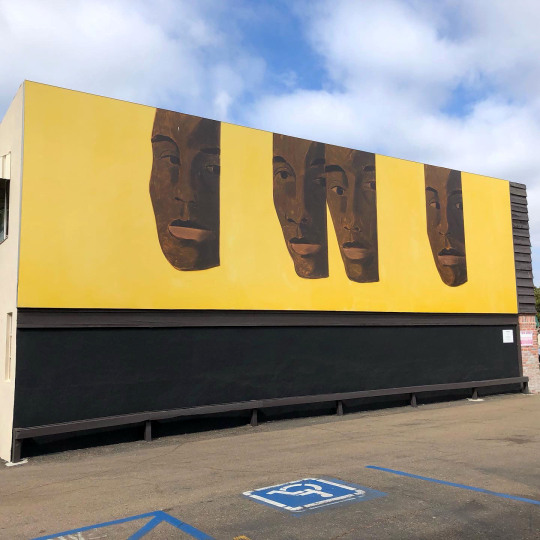

Artist Alex Katz created this mural, Bill 2, a portrait of modern dancer and choreographer Bill T. Jones, in 2019 for Murals of La Jolla in San Diego. Murals of La Jolla is a project started in 2010 by The Athenaeum and the La Jolla Community Foundation. It commissions artists to create work to be displayed on buildings around La Jolla. A map of all the murals currently on view can be found here.
From the Murals of La Jolla website about the work-
Alex Katz’s mural, Bill 2, celebrates Bill T. Jones, one of the most noted and recognized modern-dance choreographers of our time. Executed in Katz’s bold and simplified signature style, Bill 2 depicts Jones’ visage, through a series of distinct expressions. The repetition of his face has a cinematic and lyrical quality, reinforcing his place in the world of dance, music and film. Portions of the face are dramatically cropped, giving the viewer only quick and gestural glimpses of Jones. Bill 2, is a striking homage to two artists, Katz and Jones, both renowned in their respective fields of visual and performing arts. The mural’s proximity to the new Conrad Prebys Performing Arts Center gives a nod to the interconnected worlds of art, music, and dance.
The Guggenheim museum in NYC is currently showing Alex Katz: Gathering, a retrospective of the artist’s work from the late 1940’s until the present. The exhibition will be up until February 20, 2023.
From their website about the exhibition-
Emerging as an artist in the mid-20th century, Katz forged a mode of figurative painting that fused the energy of Abstract Expressionist canvases with the American vernaculars of the magazine, billboard, and movie screen. Throughout his practice, he has turned to his surroundings in downtown New York City and coastal Maine as his primary subject matter, documenting an evolving community of poets, artists, critics, dancers, and filmmakers who have animated the cultural avant-garde from the postwar period to the present.
Staged in the city where Katz has lived and worked his entire life, and prepared with the close collaboration of the artist, this retrospective will fill the museum’s Frank Lloyd Wright rotunda. Encompassing paintings, oil sketches, collages, drawings, prints, and freestanding “cutout” works, the exhibition will begin with the artist’s intimate sketches of riders on the New York City subway from the late 1940s and will culminate in the rapturous, immersive landscapes that have dominated his output in recent years.
Bill T. Jones/Arnie Zane Company has numerous performances every year. Conceived and directed by Bill T. Jones, and choreographed by Jones with Janet Wong and the Bill T. Jones/Arnie Zane Company, the latest work, Curriculum II, will be performed at on March 10, 11, and 12, at the Institute of Contemporary Art Boston.
Jones also hosts the series Bill Chats at NYC’s The New School. On January 30th, he will be in conversation with Bessie Award-winning theater director and performance artist, Niegel Smith and curator, producer, and director, Kamilah Forbes. For more events check out the New York Live Arts calendar.
#alex katz#murals of la jolla#bill t. jones#guggenheim museum#painting#la jolla#san diego murals#california murals#artist portrait#street art#murals#san diego street art#dance performance#nyc art shows#art shows#bill t jones arnie zane company#artist talks#the new school#ica boston
8 notes
·
View notes
Text
“Everybody Hollerin’ GOAT” — Derek Taylor’s 2022
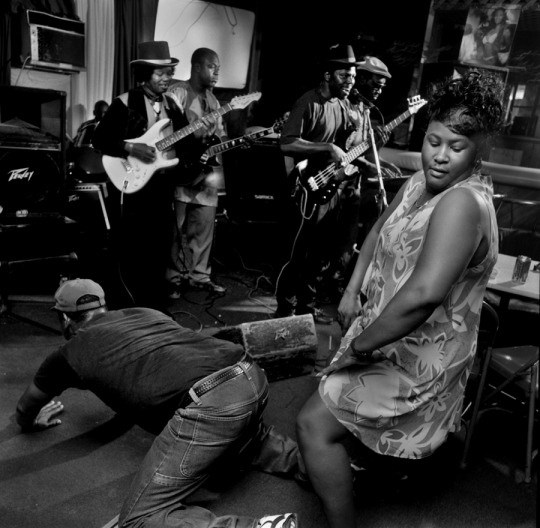
I’ve been reverentially pilfering Bill Steber’s photos as visual ledes for as long as I’ve been writing these Year End paeans (the first was in 2003, making this one the nineteenth). There’s something about Steber’s keen eye for negative space, composition and context that makes me think of Blue Note’s Francis Wolff, if transplanted to the Mississippi hill country. No blues to speak of in the stack of recordings this time around, at least as sourced from that legendary, loamy region, but still lots that’s helped keep my head screwed on and faculties relatively fog-free over the past twelve-months.
Wadada Leo Smith
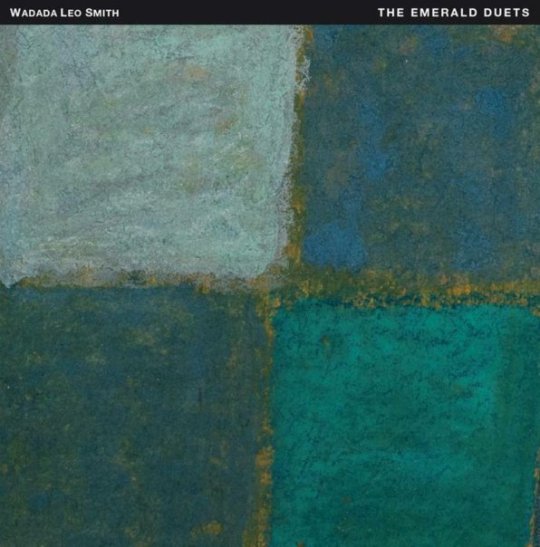
Smith’s ascendance to octogenarian eminence was simply too merry and momentous an occasion to be contained to a single year. As the concluding two entries in a hexalogy of releases on the Finnish TUM label highlighting facets of his multifarious output, Emerald Duets and String Quartets, Nos. 1-12 dropped in May and were also arguably the most ambitious. The Dusted bullpen collectively dug in on both sets in a rousing Listening Post roundtable that forgivably favored the more accessible exploratory encounters with drummers Jack DeJohnette, Andrew Cyrille, Han Bennink and Pheeroan AkLaff.
Joe McPhee

The Powerhouse from Poughkeepsie turned 83 years young in November and as with past years his productive spirit appears immune to enervation or ennui. Ensemble efforts like Survival Unit III’s The Art of Flight (Astral Spirits/Instigation) and Pride of Lion’s No Question No Answers (RogueArt) continue to be the common currency of his artistic realm, but McPhee also found aegis for the release of exhilarating duets with cellist (and freshly-minted MacArthur “genius”) Tomeka Reid (Let Our Rejoicing Rise) and British sax eidolon Evan Parker (Sweet Nothings (For Milford Graves), both pressed on the prolific Corbett vs. Dempsey imprint (see below).
Peter Brötzmann

Speaking again of unstoppable octogenarians, Herr Brötzmann came out of COVID isolation with renewed vigor and a concert calendar still compellingly competitive with musicians a fraction his age. New entries in his edifice-sized discography weren’t nearly as plentiful, but a pair of archival releases still packed a gobsmacking punch. Historic Music Past Tense Future (Black Editions Archive) drops the German reedist and bassist William Parker into the precision polyrhythmic maelstrom of Milford Graves circa spring 2002 across a double slab of vinyl. In a State of Undress (FMP/Be!) is free jazz of a more formal sort with the one-off aggregate of trumpeter Manfred Schoof, bassist Jay Oliver and drummer Willi Kellers tempering the leader’s orotund edges.
Tyshawn Sorey + Greg Osby — The Off-Off Broadway Guide to Synergism (Pi)
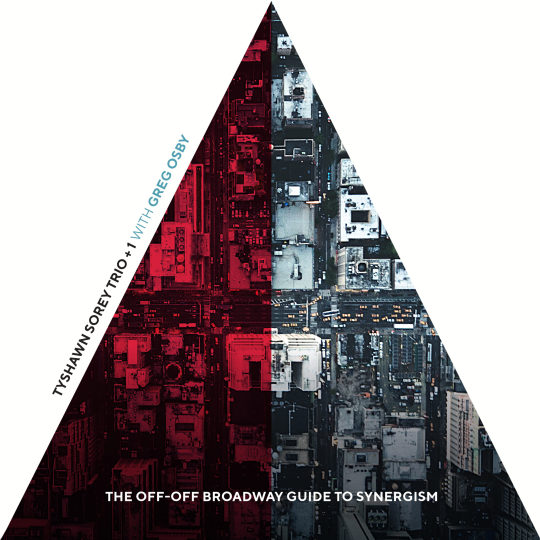
Keeping up with Tyshawn Sorey’s indefatigable activities is a lot like keeping pace with Joe McPhee, a full-time pursuit worth every penny and effort. This three-disc set has the instant enticement of capturing his working trio in the hothouse context of an extended gig at the Jazz Gallery in NYC. Add to that a program of alchemized standards sourced from the Great American Songbook and jazz brethren along with altoist Greg Osby in a rare sideman station and the results become an irresistible trigger pull. In a word: epic.
Cecil Taylor

Taylor’s been gone four-plus-years, but his in-life prolificacy continues to bestow posthumous gifts. Revelatory and digital-only, The Complete, Legendary, Live Return Concert at the Town Hall, NYC, November 4, 1973 (Oblivion) expands greatly on its previously truncated incarnation, Spring of Two Blue-J’s originally on Taylor’s own Unit Core imprint back in 1974. Respiration (Fundacja Słuchaj!) and Live in Ruvo Di Puglia 2000 (Enja) reveal previously unreleased prototypes of his solo repertoire separated by the span of thirty-two years. Sharing a surname with the pianist probably suggests the presence of bias, but I will still ardently go on record in stating that all three are essential.
Albert Ayler — Revelations: The Complete ORTF 1970 Fondation Maeght Recordings (Elemental)

Previous editions of this material are now obsolete thanks to this magnificent, meticulously assembled set. So invasive were earlier edits and excisions, particularly as concerns the catalytic contributions of Ayler’s life and musical partner Mary Parks (aka Mary Maria), that it’s like hearing the concerts anew. Parks’ memory and jazz history are restored by producer Zev Feldman and his retinue of collaborators. The results are glorious, both in terms of restored fidelity and the extended majesty of Ayler’s last band firing on collective, conflagratory cylinders.
Chris Dingman — Journeys Vols. 1 & 2 (Inner Arts)

Chris Dingman nearly topped my Year End list two-years ago with an ambitious five-disc opus Peace, a dedicatory body of work for solo vibraphone initially conceived as an aural paregoric for his ailing father. The elder Dingman passed away prior to its release and in navigating the grief in the years since, the son’s doubled down on the unaccompanied format as means of realizing Albert Ayler proffered adage that “music is the healing force of the universe.” Journey’s 1 & 2 reflect their predecessor, but also refract it through a sequence of malleted excursions emphasizing melody and repetition in rippling, elliptical patterns that soothe and enthrall.
Corbett vs Dempsey
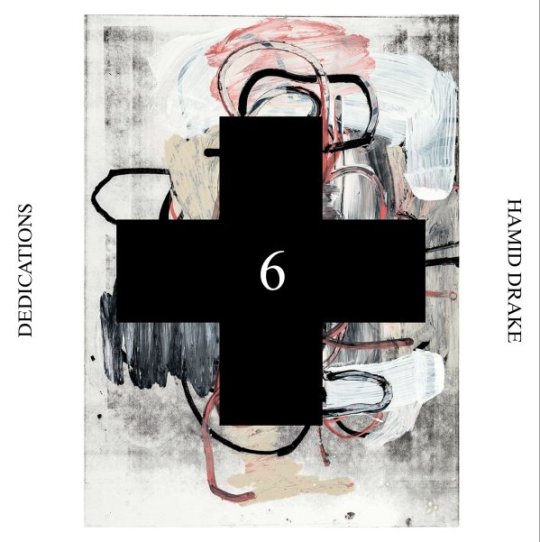
John Corbett is indicative of my favorite species of record collector: an altruist whose obsessiveness in the endeavor is exceeded by his ardor for sharing the spoils of this searches through reissues that completely do the artifacts justice. Chief among the offerings this year, German free jazz pianist Georg Gräwe’s first two forays as a leader, New Movements (1976) and Pink Pong (1978), and the pivotal Globe Unity (1967), which restores Alexander von Schlippenbach’s first multinational large ensemble enterprise to circulation. Also of note, another stack of entries inspired by the Sequesterfest series of concerts initiated during the pandemic. Drummer Hamid Drake’s Dedications features solo percussion-planted encomia to his influences and is probably my pick of the eight titles released so far.
The Pyramids — Aomawa: The 1970s Recordings (Strut)
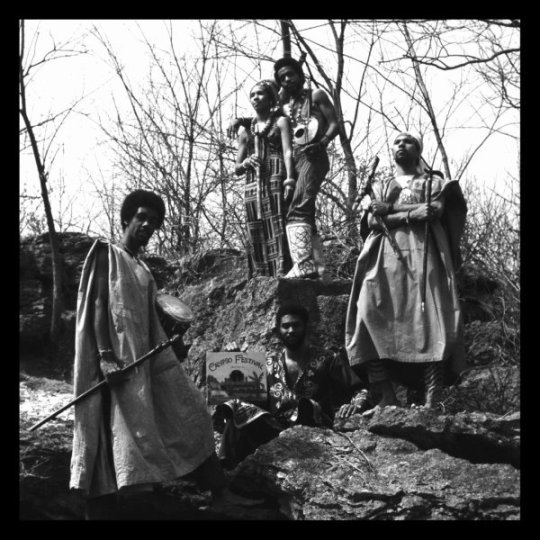
A box set that brings a personal blind spot into bracing focus and rectifies it. The Pyramids initial three albums plus a concert air shot given the deluxe treatment by the Strut label. Ancient to the Future with audible Sun Ra Arkestra and Art Ensemble influences, reedist Idris Ackamoor’s ensemble is never slavish or supine in its interpretations of precedence. Percussion jams are plentiful, as are spiritual jazz overtones, and it all combines in an earthy gestalt that also has a healthy respect and acumen for groove. I’m of an age where regrets feel increasingly impractical, but it’s still good to catch up.
Grounation — The Mystic Revelation of Rastafari (Soul Jazz)
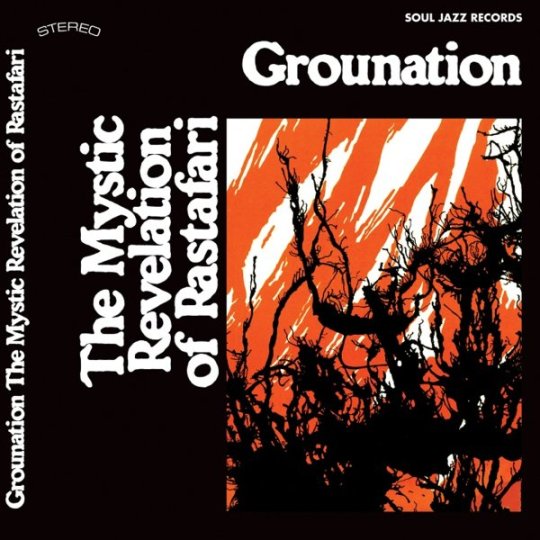
An arguable Jamaican analog to Aomawa in its assemblage of certain analogous ingredients, Groundnation was also something else entirely. Sprawling across three LPs (a milestone in the country’s recording industry), The Mystic Revelation of Rastafari resonates as history lesson, call to arms, sacred text, and adulatory celebration among other appellations. Count Ossie, Cedric IM Brooks and their confreres mined both zeitgeist and musical alloy that had lasting effects not just on reggae, but self-determinate roots-oriented music of all sorts. Soul Jazz’s painstaking attention to accurate reproduction and contextualization is admirable and immersive.
Robbie Basho — Bouquet (Lost Lagoon)

Self-produced, released and circulated in 1984, Basho’s penultimate album tests and perhaps proves the prevailing theory that detractors of his singing far outnumber those of guitar playing. Still, he succeeds where other great polarizers of the pipes like Irene Aebi, Yoko Ono and Ethel Merman fail in his unflappable earnestness and credulity. The self-doubt and cumulative frustrations that haunted Basho in life subsume in the sincerity of his music, strangely sui generis in its intensely personalized strains of borrowed religion, spirituality and mysticism. Mileage varies, but there’s no denying Basho’s commitment to his muses.
Sun Ra

Labels like Modern Harmonic and Cosmic Myth Ra continue to keep Ra relevant even though the Saturnian left the planet decades ago. This year’s passel of reissues includes timely returns of Ra to the Rescue and Universe in Blue, each augmented with extra and/or extended tracks. The latter album includes several showstopping John Gilmore spotlights and ample Ra organ-omics while the former gets its most complete edition yet with a survey of snapshots across 1970s sessions. A genuinely new release, Prophet zeroes in on Ra’s 1986 in-studio experiments with the then-newfangled eponymous console and he responds like a kid in a keyboard candy store with select Arkestral band members, including an ailing June Tyson, in exuberant, if fleeting, support.
Steeplechase

The Danish label is an old reliable in these pages, plugging along with current releases from its international stable of artists alongside occasional, but always welcome, reissues. Stephen Riley’s My Romance isn’t the tenorist’s first recording with B-3 organ, but it does mark his first as a leader. Electing Brian Charette to cover the keys with just Billy Drummond on cans in support is a stripped-down stroke of genius. Vintage concert performances with bop pianist Duke Jordan in the company of Danish tenorist Bent Jaedig (Montmartre ’73) and archival recordings by tenorist Brew Moore (Special Brew) and dearly departed Philly guitarist Monette Sudler (In My Own Way) stand out, too.
Bear Family
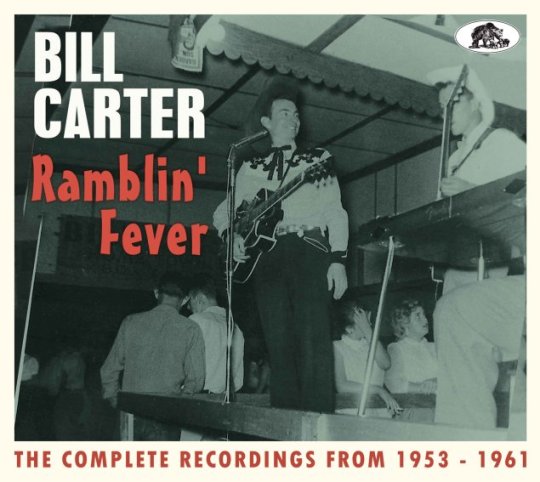
Bear Family basically has access to a bank vault-sized archive when it comes to vintage country fare. It’s a mighty good thing because Bill Carter holds at best token traction with the 21st century arbiters of the genre. Sixty-seven tracks across two discs chart the ups, downs, and all arounds of Carter’s career (The Complete Recordings from 1953 to 1961) jumping from Western Swing to hillbilly to honkytonk to rockabilly. Perhaps best of all, Carter was 92, lucid, and around to see the release back in March. Western Swing legend Bob Wills’ younger brother Billy Jack was the recipient of similar treatment with Cadillac In Model ‘A’, a comparatively stingy 31-track survey and latest in the label’s long running Gonna Shake This Shack Tonight series.
Ezz-thetics

Born out of both providence and necessity, the Ezz-thetics label exists in the continued absence of the venerated Hat Hut lineage of imprints. The earlier catalogs are tied up in legal proprietary knots, leaving owner Werner X. Uehlinger to throw caution to the curb and pursue a longstanding dream of applying his decades-honed judgment as a producer to free/jazz classics. The venture immediately ran afoul of critics who took umbrage with his audacity in side-stepping stateside copyright considerations and reimagining sacred texts. Wherever one opines on those controversies, there’s no denying the new lease audio engineer Michael Brandli has accorded the source materials. Cecil Taylor’s (With) Exit to Student Studies Revisited, Paul Bley’s Play Annette Peacock Revisited, and Sun Ra’s Nothing Is… Completed & Revisited are exemplary stand outs.
Fresh Sound

Lisbon-based Fresh Sound is another reissue label that continuously courts its share of contention. The logical, if admittedly self-serving counter is that American rights holders to nearly all of the music that they traffic in couldn’t be bothered to apply even a fraction of the care or quality they bring to bear. Exacting attention to the most esoteric and obscure jazz artists has long been the archetype. This year’s batch includes definitive collections of trumpeter Dave Burns (1962 Sessions), baritone saxophonist Virgil Gonsalves (Jazz in the Bay Area 1954-1959), altoist Joe “Mouse” Bonati (Portrait of a Jazz Hero) and Belgian vibraphonist Fats Sadi (Sadi’s Vibes: A Retrospective 1953-61).
Morteza Mahjubi — Selected Improvisations from Golha, Parts 1 & 2 (Death is Not the End)

Tempered instruments aren’t an intuitive match for micro-tonal composition, but that hasn’t hindered musicians of manifold ethnicities from adapting them to the intricacies of indigenous music. Iranian pianist Morteza Mahjubi did so prolifically during his lifetime, recording his innovations for Golha (Flowers of Persian Song and Poetry) radio programs between 1956 and his passing in 1965. Spread over two album-length discs (with hopefully future volumes to follow), Mahjubi applies his custom tuning system to the ivories and approximates the sonorities of endemic instruments like the tar (lute) and santur (hammered dulcimer).
Branko Mataja — Over Fields and Mountains (Numero)

Mataja’s biography reads like a Spielbergian screenplay. Abducted from his native Belgrade and conscripted to a German work camp during WWII, the lifelong guitar enthusiast worked a variety of trades after being liberated, before emigrating to England, then Canada, and finally a string of stateside cities. Mataja eventually settled in Los Angeles where he worked as a barber and started a side business a freelance guitar technician. Memories of his home country haunted him, and he recorded a pair of albums in his garage studio/workshop from which this LP is sourced. Milky, murky reverb and sustain are calling cards, alongside an improvisatory approach to traditional Croatian melodies that’s equal parts melancholic and mysterious.
V/A — Padang Moonrise: The Birth of the Modern Indonesian Recording Industry 1955-1969 (Soundway)

A double-LP + 7” survey stacked with sublime discoveries from coordinates geographic and temporal that beg for an even deeper dive. Reverb-dipped guitars and swirling, droning organs are persistent common denominators alongside varied hand percussion and a revolving cast of melancholic crooners across genders and dialects. It’s cross-cultural music that’s exotica-adjacent and still ripely redolent of American soul. Ghost World’s Enid would’ve had a field day immersing herself in this stuff. I know I have.
Jalaleddin

Old, but still new to me, and perhaps my most listened to platters among the many vinyl discoveries procured on record shop safaris this year. Discogs lists seven albums to Jalaleddin’s name, and I feel fortunate to have found six on the cheap in a single shop. Based in San Francisco in the 1970s and a master of the kanun (Turkish trapezoidal zither,) Jalal Takesh started his musical career cutting belly dance records. Benefiting from a Santana-like broadmindedness, his bandleading would soon conscript musicians of other traditions including Indian ragas, Greek rebetika, and Spanish flamenco. Hand-sketched and colored by an academic friend of Takesh’s, the album cover illustrations are aces, as well.
25 More in No Fixed Order…
Andrew Cyrille/William Parker/Enrico Rava — 2 Blues for Cecil (TUM)
Michael Bisio Quartet — MBefore (Tao Forms)
Ingrid Laubrock/Brandon Lopez/Tom Rainey — No Es La Playa (Intakt)
Patricia Brennan — More Touch (Pyroclastic)
Mark Turner — Return from the Stars (ECM)
Jeb Bishop/Pandelis Karayorgis/Damon Smith — Duals (Driff/Balance Point Acoustics)
Ches Smith — Interpret it Well (Pyroclastic)
Sam Rivers — Caldera (NoBusiness)
Toots Thielemans & Rob Franken — The Studio Sessions 1973-1983 (Dutch Jazz Archive)
The Pyramids — Penetration! (Sundazed)
Horace Tapscott Quintet — S/T (Mr. Bongo)
V/A — Girls with Guitars Gonna Shake (Ace)
John Ondolo — The Hypnotic Guitar of John Ondolo (Mississippi)
Biluka y Los Canibales — Leaf-Playing in Quito 1960 to 1965 (Honest Jon’s)
Myra Melford’s Fire & Water Quintet — For the Love of Fire & Water (RogueArt)
Ndikho Xaba & The Natives — S/T (Trilyte/Mississippi)
Brandon Seabrook — In the Swarm (Astral Spirits)
Sirone — Artistry (Moved by Sound)
William Parker — Universal Tonality (Centering)
Charles Mingus — The Lost Album from Ronnie Scott’s (Resonance)
Markos Vamvakaris — Death is Bitter (Mississippi)
Jeff Parker — Mondays at the Enfield Tennis Academy (Eremite/Aguirre)
Mal Waldron — Searching in Grenoble: The 1978 Solo Piano Concert (Tompkins Square)
Allan Botschinsky Quintet — Live at The Tivoli Gardens 1996 (Stunt)
Jimmy Castor Bunch — The Definitive Collection (Robinsongs)
Derek Taylor
#yearend 2022#dusted magazine#derek taylor#wadada leo smith#joe mcphee#tyshawn sorey#greg osby#cecil taylor#albert ayler#chris dingman#corbett vs dempsey#hamid drake#the pyramids#grounation#robbie basho#sun ra#steeplechase#stephen riley#bear family#bill carter#ezz-thetics#paul bley#fresh sound#fats sadi#morteza mahjubi#branko mataja#Padang Moonrise#jalaleddin
3 notes
·
View notes
Note
what the fuck did you do😭😭😭
also how was NYC? you’re back and writing so i’m assuming you’re back and have rested
i didn't do anything !!! these characters on the other hand..... 😬
my trip was really fun~ i didn't write at all haha which i think i needed! in general i'm trying to incorporate a little more balance into my life of doing more social and restful activities alongside my writing. it means my output's probably gonna slow down a bit but i think it'll be better for me long-term 🫡 so hopefully y'all are okay with that! 💜
5 notes
·
View notes